

Useful Phrases to Give a Presentation in Spanish
¿has dado alguna vez una presentación en español .
Si es así, ya sabes que puede ser bastante difícil pensar en las palabras correctas cuando todos te están mirando. ¡Cuánta presión y qué nervios!
Bueno, no te preocupes, porque en esta entrada aprenderás una serie de frases en español que te ayudarán a que tus presentaciones sean más profesionales.
INTRODUCCIÓN

Al comienzo de tu presentación sería ideal seguir los siguientes pasos:
- Preséntate a ti mismo y a tu tema.
- Haz un resumen de tu exposición.
- Dile a la audiencia cómo manejarás las preguntas.
Para presentarte di tu nombre, en qué empresa trabajas y/o cuál es tu trabajo específico:
“Buenas tardes. Mi nombre es (tu nombre) y soy (tu trabajo) en (tu empresa)” .
Luego, puedes decirle a la audiencia cuál es el tema general. Aquí hay dos frases que puedes usar:
“Mi presentación es sobre…”
“Hoy me gustaría hablarte de…”
Siempre es una buena idea darle a la audiencia un resumen o una descripción general de su presentación. Recuerda dirigirte a tu público tratándoles de USTED :
“Permítanme darles una descripción general de la presentación de hoy”.
“En primer lugar voy a hablar de… (tema 1)”
“Después de eso, echaremos un vistazo a… (tema 2)”
“Entonces, consideraremos… (tema 3)”
“Y finalmente, explicaré… (tema final)”
Luego, dile a la audiencia si desea que la gente le haga preguntas en medio de la presentación o solo al final. Aquí hay una frase para cada uno:
“Por favor, siéntase libre de interrumpirme si tiene alguna pregunta”.
“Dejaré algo de tiempo para preguntas al final de la presentación”.
HACER TRANSICIONES ENTRE TEMAS
Para comenzar el primer tema, puedes usar frases como éstas:
“Me gustaría comenzar por/con… ”.
“Empecemos por… ”.
En este contexto, las palabras “comenzar” y “empezar” significan lo mismo.
Para pasar a otro tema, puede usar estas frases:
“Ahora vamos a pasar a…”
“Ahora veamos…”
“Ahora me gustaría discutir…”
“Ahora déjame pasar a…”
Notarás que todos comienzan con la palabra “ahora”: esta es una señal para tu audiencia de que estás presentando un nuevo tema.
CON REFERENCIA A DIAPOSITIVAS / GRÁFICOS

Si estás dando una presentación en PowerPoint, querrás consultar las diapositivas, que pueden mostrar imágenes, mapas, gráficos, cuadros, tablas, etc.
Aquí hay algunas frases que puedes usar:
“Esta diapositiva muestra… ”.
“Mirando esta diapositiva, podemos ver que… ”.
“Como puede ver en esta diapositiva…” .
REPITIENDO / CORRIGIENDO

¿Qué harías si dijeras algo incorrecto o confuso durante tu presentación?
Primero, ¡no te pongas nervioso/a! Los hablantes nativos de español también cometen errores durante las presentaciones, así que ¡no es el fin del mundo!.
Aquí tienes algunas frases para retomar el rumbo:
Frases para decir algo de nuevo usando diferentes palabras:
“Déjeme decirlo de otra manera”.
“Déjeme reformular eso”.
“En otras palabras…”
Frases para corregir un error:
“Lo siento, eso no es correcto. quise decir que… [hemos contratado a 15 nuevos empleados, no a 50] ”.
Disculpe + corrección con énfasis.
Por ejemplo: “La escuela fue fundada en 1999, disculpe , mil novecientos ochenta y nueve”.
Frases para describir efectos:
Por lo tanto … (usualmente usado para una conclusión lógica)
Este producto es más caro de producir. Por lo tanto, los márgenes de beneficio son más bajos.
En consecuencia … (más formal)
La empresa no obtuvo el permiso de construcción adecuado. En consecuencia, tuvimos que pagar una multa por incumplimiento.
Como resultado …
Hemos invertido en mejores equipos de seguridad y, como resultado , la cantidad de accidentes se ha reducido .
Entonces …
Los anuncios tuvieron éxito, entonces , ahora planeamos expandir el programa.
Las palabras “por lo tanto” y “en consecuencia” se usan típicamente al comienzo de una oración. “Como resultado” se puede usar al principio o al final de una oración, y la palabra “entonces” se usa típicamente en el medio de una oración.

Al final de su presentación, puede dar un breve resumen de sus puntos principales o el mensaje más importante. Aquí hay algunas frases para eso:
“En conclusión…” “Cerraré resumiendo los puntos principales”. “Permítanme recordarles brevemente lo que hemos cubierto”. Como frase final, puedes decir: “Gracias por su atención.”

Para informar a la audiencia que está listo para responder preguntas, puede decir:
“¿Alguien tiene alguna pregunta?” (generalmente se hace en una reunión/grupo más pequeño)
“Me gustaría dar paso a las preguntas ahora”. (generalmente se hace cuando se presenta a un grupo más grande)
Si no entendió la pregunta de la persona, puede decir: “Lo siento, no entendí eso, ¿podrías repetirlo?”
“Lo siento, no entiendo muy bien tu pregunta, ¿te importaría reformularla?” Las expresiones “lo siento” y “te importaría” se incluyen por cortesía.
Si la pregunta requiere información que no tienes en este momento, pero que podrías averiguar más adelante, puedes decir esto: “Esa es una pregunta interesante. En realidad, no lo sé muy bien, pero intentaré responderte más tarde con una respuesta”.
Si no puede responder la pregunta, pero alguien más puede, entonces diga: “Desafortunadamente, no soy la mejor persona para responder eso, pero puedo ponerlo en contacto con un colega mío” .
Finalmente, si la respuesta a la pregunta va a ser muy larga, puede decir: “Me temo que tomaría mucho tiempo explicarlo, pero tal vez tú y yo podamos hablar de eso más a fondo después”. Esto significa que no desea responder la pregunta de inmediato, pero está dispuesto a hablar con la persona al respecto después de la presentación.
Esto es todo por ahora.
Espero que te sea muy útil.
Deja un comentario Cancelar la respuesta
BASIC INFORMATION ON DATA PROTECTION Responsible: Teresa Buendia (Teresa Buendía) Purpose: To moderate and respond to user comments Legitimation: Consent of the interested party Recipients: Will not be sold to third parties except legal obligation. Rights: You can exercise at any time your rights of access, rectification, deletion, opposition and other legally established rights through the following e-mail: [email protected]. Additional Information: You can consult the additional and detailed information on data protection here.
Guarda mi nombre, correo electrónico y web en este navegador para la próxima vez que comente.
By making your comment you accept the Privacy Policy *
Privacy Overview
- PRO Courses Guides New Tech Help Pro Expert Videos About wikiHow Pro Upgrade Sign In
- EDIT Edit this Article
- EXPLORE Tech Help Pro About Us Random Article Quizzes Request a New Article Community Dashboard This Or That Game Popular Categories Arts and Entertainment Artwork Books Movies Computers and Electronics Computers Phone Skills Technology Hacks Health Men's Health Mental Health Women's Health Relationships Dating Love Relationship Issues Hobbies and Crafts Crafts Drawing Games Education & Communication Communication Skills Personal Development Studying Personal Care and Style Fashion Hair Care Personal Hygiene Youth Personal Care School Stuff Dating All Categories Arts and Entertainment Finance and Business Home and Garden Relationship Quizzes Cars & Other Vehicles Food and Entertaining Personal Care and Style Sports and Fitness Computers and Electronics Health Pets and Animals Travel Education & Communication Hobbies and Crafts Philosophy and Religion Work World Family Life Holidays and Traditions Relationships Youth
- Browse Articles
- Learn Something New
- Quizzes Hot
- This Or That Game
- Train Your Brain
- Explore More
- Support wikiHow
- About wikiHow
- Log in / Sign up
How to Say “Welcome” in Spanish
Last Updated: April 19, 2024
This article was co-authored by Language Academia . Language Academia is a private, online language school founded by Kordilia Foxstone. Kordilia and her team specialize in teaching foreign languages and accent reduction. Language Academia offers courses in several languages, including English, Spanish, and Mandarin. This article has been viewed 203,366 times.
There are four different ways to say “welcome” in Spanish, depending on whether you’re using this word in a sentence as a greeting, noun, transitive verb, or adjective.
Using “Welcome” as a Greeting

- When greeting a woman, say “bienvenida,” which is the feminine translation of “welcome.” “Bienvenida” is pronounced “bee-en-veh-nee-dah.”
Using “Welcome” as a Noun

- Alternately, you can say “recibimiento” or “acogida,” which are synonyms for “welcome” as a noun in Spanish. “Recibimiento” is pronounced “reh-see-bee-mee-en-toh,” and “acogida” is pronounced “ah-koh-hee-dah.”

The most common Spanish greeting is 'Hola', which literally translates to 'Hello'. However, you can make your welcome warmer by using 'Bienvenido' (masculine) or 'Bienvenida' (feminine), which mean 'Welcome'. For a friendly, informal welcome, say '¡Hola! ¡Bienvenido!' or '¡Hola! ¡Bienvenida!' Be sure to match the gender to who you are addressing. Add a smile, and you'll spread cheer Spanish style!
Using “Welcome” as a Transitive Verb

Using “Welcome” as an Adjective

Community Q&A
You Might Also Like

- ↑ http://www.spanishdict.com/translate/welcome
- ↑ http://www.nglish.com/spanish/en/welcome
- ↑ http://www.spanishcentral.com/translate/bienvenida
- ↑ https://www.collinsdictionary.com/us/dictionary/spanish-english/bienvenido
About This Article

- Send fan mail to authors
Reader Success Stories
M. Benjamin
Dec 21, 2016
Did this article help you?
Featured Articles

Trending Articles

Watch Articles

- Education and Communications
- World Languages
- Terms of Use
- Privacy Policy
- Do Not Sell or Share My Info
- Not Selling Info
wikiHow Tech Help Pro:
Level up your tech skills and stay ahead of the curve
How to: Feel Comfortable Giving a Presentation in Spanish
Dear Esther,
Giving a presentation in any language can be scary, but when you have to present to people you don’t know, in a language you might not dominate (or even if you are fluent ), it can be downright terrifying. However, as an experienced presenter in Spanish—read here and here about how I did my entire degree abroad—I am here to tell you that you can do it! And it doesn’t have to be as scary as you initially think. Here are my top tips for getting through your presentations in a foreign language:
Prepare your notes:
Even if you are able to make things up as you go along in English, you should be aware that it is more difficult to control a topic in a non-native language. Therefore, take the extra hour or two to make sure you know what you want to say and how you want to say it. I know a lot of people—from all different backgrounds alike—who don’t bother to take the time to truly prepare their presentations and you can tell when they present. In addition, it will make life easier if you properly organize the content before you start preparing the presentation because then you will have you bases covered.
Pro-tip: If you’ve already prepared an assignment or paper around the topic, use this as your guide (even if it is in English). This will help you feel comfortable that you say what you have to say.
Prepare your slides:.
Once you know what you want to say and how you want to say it, you can start to prepare the visual part of your presentation (whether it be a PowerPoint, Prezi, or other tool). Make sure that the visual cues you give yourself help your words flow. My personal preference is to use a little bit of text and let your words speak for themselves (you don’t want people reading the slides instead of listening to you). Consider using keywords or photos that you can connect to your content instead of reading directly off the slide. At the same time, make sure you know what works for you and prepare accordingly.
Think about it this way: Your slides should act as an outline for what you want to say, helping your listeners follow along or jot down key points. However,if you need notes, consider bringing them along separately.
While you may feel stupid talking to yourself (maybe in front of a mirror) or practicing with your housemate, the first time through a presentation always feels harder than the second or third. If you have time to practice a time or two before you get in front of your final crowd, you can make sure you feel your way around words that you don’t feel comfortable with (potentially switching them out for others) and confirm that your presentation makes sense.
Pro-tip: if possible, try to rehearse with a native Spanish speaker who can help you figure out if what you say is clear or not. And remember that constructive criticism in your practice moments is a good option in comparison to your professor not understanding you during the presentation.
Relax and smile:.
A big part of the quality of the presentation is how comfortable you are with yourself. Even if you don’t feel like you really know the content or you are worried about presenting in front of your class, your attitude will affect the perception the audience has of your knowledge. If you are able to get up in front of everyone and act in a calm, collected way (despite the fact that you are shaking inside), that will go a long way towards a good presentation.
Try it: I found the video below that talks about about how body posture impacts our perception of a situation and I have never gone back—before every presentation you can find me in superhero pose!
It’s not the end of the world:
I just want to remind you that, at the end of the day, if your presentation is terrible it is not the end of the world. Honestly, as someone who has been there, it is commendable that you are potentially getting up in front of a whole class of native speakers to give a presentation in a language that you are only more or less comfortable with. Personally, the most important thing is to notice how you feel during the presentation and figure out ways that you can ‘do it better’ next time. Like anything, practice makes it easier, but sometimes we have to fall before we can fly.
We would love to hear about your presentation experiences while abroad. Are you a nervous presenter or are you as cool as a cucumber? Let us know!
Sincerely, Spain
P.S. I would just like you all to know that while I am a good presenter, I am not always (read almost never) comfortable when presenting, I am just good at hiding it. It has allowed me to ace presentations—not only at school but also in front of other crowds—and job interviews. Therefore, I believe it is a skill worth developing.

Related Posts

Confessions: I Speak Differently to Different People

Making Friends as a Foreigner in Finland

Adapting to a New Culture: Claudia’s Experiences
Leave a reply cancel reply.
Your email address will not be published. Required fields are marked *
Save my name, email, and website in this browser for the next time I comment.

Spanish Oral Presentation Guide for Beginners
by TruFluency | Featured Spanish Blog , Learn Spanish , Spanish Presentation

The moment to show off your Spanish skills is here, and we’ll teach you how to wow your audience, coworkers, boss, or clients. The way you introduce and close your presentation can have a positive or negative effect on your audience. So, it’s normal that you get nervous about speaking in front of a crowd and communicating your ideas effectively.
Practicing oral presentations in Spanish helps you focus on pronunciation and clarity while broadening your academic, job, and business opportunities . However, what may be even more valuable is that it gives you the chance to take risks, gain confidence, and exercise persuasion in a foreign language.
If you have a presentation soon, and want to blow everyone’s mind, here is your guide to giving oral presentations in Spanish for beginners.
5 Engaging Presentation Openings
The first part of our Spanish oral presentation guide is to help you find the most engaging ways to open your speech.
1. Start with a Reflexive or Engaging Question
For example:
¿Sabían ustedes que la entonación de nuestra voz no es sonido sino emoción? (Did you know that the intonation of our voice is not sound but emotion?)
Starting with a question allows you to keep your audience attentive throughout your message.
2. Tell an Anecdote
55% of our communication stems from non-verbal language ; everything our audience reads through our expressions, mannerisms, tone, etc., while 38% of our communication is vocal and 7% is words.
Hence, the importance of telling a story at the beginning of your presentation, so your audience connects with what you are going to deliver. We are all natural communicators.
At first, you may feel shy about opening yourself to the world, but believe it or not: your story counts, your story inspires, and even more than you think.
3. Utilize Objects
Generate interest with an object that’s relevant to your message. For instance, you can follow a similar script to this one:
Esta cartera que hoy acompaña mi atuendo tiene un significado muy especial. Esta cartera ha sido elaborada, tejida y pensada por gente que cree en sus sueños. ¡Qué gusto estar el día de hoy aquí hablando con emprendedores que creen en construir!
(This purse that matches my outfit today has a very special meaning to me. This purse has been sewn, knitted, and created by people that believe in their dreams. What a pleasure to be here today talking with entrepreneurs that believe in building things!)
Utilizing resources as elements of your speech will help your public to relate and feel part of your speech. Everything has a meaning and a representation. Remember that your public will forget what you said but will always remember how you made them feel. So, make them feel welcome!
4. Statistics
Using statistical data will help give your statement a significant rational weight. Remember that statistics aren’t read, they’re interpreted. This forces you to describe exhaustive research about a topic.
This isn’t about boring your audience with numbers, it’s about using statistics as a tool to make people reflect on your message. An example of an introduction in Spanish with statistics is:
¿Sabían ustedes que el 80% de los consumidores que adquieren sus productos en línea confían más en las recomendaciones de sus amigos o familiares que de las propias empresas?
(Did you know that 80% of consumers that buy your products online trust more in the recommendations of their friends and family than on the ones of companies?)
5. Who are you?
Greet your audience. This is fundamental to bond with them. Say your name, who you are, what your topic is and why it is important to pay attention to you. Let’s put it into practice with this example:
Hoy me encuentro feliz de estar con ustedes compartiendo lo que sé. Mi nombre es Liam Jones, soy periodista y locutor de radio, y hoy quiero que aprendas a utilizar tu voz para hacerte escuchar.
(Today I am very happy to be with you sharing what I know. My name is Liam Jones. I am a journalist and radio host, and I want you to learn to use your voice to make yourself heard.)
Respect your essence, know yourself and regularly practice the above types of introduction.
Verbal and Non-Verbal Presentation Tips
The next part of our Spanish oral presentation guide is divided into verbal and non-verbal language.
Non-Verbal Language Tips
Your gestures can emphasize, substitute or contradict what you express with words.
Use open gestures, like moving your hands, stretching your arms and legs, and opening your shoulders. Additionally, avoid having objects in your way between your body and the audience, such as folders, books, and tables. Your face should be visible all the time.
Choose gestures that ease people’s understanding of your speech. For example, pointing in a direction.
Avoid fidgeting out of nervousness. For instance, touching your hair or glasses.
Distribute your gaze amongst your audience, so everybody feels included. You can divide your audience into different quadrants. Let’s say, four, and choose a person of each quadrant to “talk to”.
Volume and Intonation
Mentally “take measurements” of the room, so the volume you choose to use is enough for both people in the front row and in the back to hear you. Also, avoid monotonous intonation. Highlight with your voice the keywords of your speech.
Rhythm and Pronunciation
Slow down when you need to separate ideas, this reflects confidence and helps you recover people’s attention. Pronunciation should be clear , so be careful with mumbling sounds.
Nobody has the right to tell you how to dress, but it’s recommendable that your attire matches both your personality and the context of your presentation.
Verbal Language Tips
Order and structure.
A presentation that has order and structure is easy to follow, understand, and remember.
Organize your speech in parts. For example: importance, data, chronology, interesting bullet points, zoom in, and zoom out.
Use discourse markers; words that organize and connect ideas. Some examples are:
To Start Interventions El objetivo de esta exposición es… / Hablaré en primer lugar de… / Para comenzar… (The objective of this presentation is… / Firstly, I’ll speak about… / For starters…)
To Introduce Comments or Examples Por ejemplo… / Como es el caso de… / Recordemos, en ese sentido, que… (For example… / As is the case with… / Let’s remember, in this sense, that…)
To Structure the Discourse En primer lugar… / En segundo lugar… / Por un lado,…por otro lado… / Finalmente… (In first place… /In second place… /On the one hand…on the other hand… /Finally…)
To Resume the Subject Volviendo a lo que hemos visto al principio… / Como decía… / Señalaba que… (Going back to what we’ve seen at the beginning… /Like I was saying… / I was pointing out that…)
To Establish Logical Relationships Consecuentemente… / Eso nos demuestra que… / Deducimos, entonces… (Consequently… / That shows us that… / We deduce, then…)
To Conclude Tratemos, finalmente, el último aspecto… / En resumen,… / Para terminar… / En conclusión… (Let’s address, finally, the last aspect… / In summary… / Lastly… / In conclusion…)
You should adapt it to your audience’s knowledge, formality level, and the purpose of your presentation.
Sentences should be short and simple. Avoid the overuse of muletillas (catch phrases).
Oral Presentation Conclusions in Spanish
When you’re giving a presentation in Spanish, do not miss the chance to leave a good impression. The final part of a speech is what we remember the most. So, use it to deliver a message or briefly summarize what you want to convey. You can create a compelling conclusion with a phrase, rhetorical question, quote, or call-to-action.
En conclusión, cualquiera puede padecer de un problema de salud mental. (In conclusion, anyone can have a mental health problem.)
Si las personas más brillantes pueden padecer problemas de salud mental, ¿por qué nosotros no? (If the most brilliant people can have mental health issues, why can’t we?)
La mente es como un paracaídas, si no se abre, no sirve para nada. Muchas gracias, público oyente, por haber abierto su mente a escucharme en esta exposición. (The mind is like a parachute, if it isn’t opened, it doesn’t work. Thank you very much, listening public, for having opened your minds to listen to me in this presentation.)
Ready to be confident in your next Spanish oral presentation?
The key to giving a memorable oral presentation in Spanish is to be original, creative, and do something that’s unusual but true to your essence. Thus, you’ll make the difference.
If after reading our Spanish oral presentation guide, you think you still need help to prepare yourself for your Spanish presentation, count on our top-notch team of Spanish fluency coaches . So, don’t let fear of success hold you back, and book with one of our coaches.
Save 20% off your first month of lessons with code TF20 today!
Popular Posts
Latest blogs.


Stage 1: Greetings and presentations in Spanish
English translation of podcast audio
Spanish Route, episode ONE. Your guided route to Spanish.
Good morning, good afternoon or good evening. Welcome to Spanish Route. The program, the podcast, to learn Spanish in the easiest and most fun way. My name is Sergio and I am your personal Spanish trainer.
This is the first program and it’s going to be very easy, you’ll see.
We will learn to introduce ourselves and to greet us. We will ask some questions and answer them. That way you’ll know me a little better.
But first, I want to remind you that on my website: SpanishRoute.com You can read the transcription and English translation of this program. In case there is something you have not understood well. You can download the pdf with the presentation of the class and with a very easy written exercise to help you practice the concepts we have talked about today.
Also, from spanishRoute.com/contact , you can write me with questions that we will solve in the program.
And if you want to access Skype conversation sessions with me , at a very low price.
Remember SpanishRoute.com. And now Let’s start with the program.
In this first chapter we will start at the most basic level. We will learn to introduce ourselves and to greet us.
Remember that this program can be followed from the audio player of my website, or through your favorite podcast player.
And besides, in case you find it difficult to follow me, you can also watch the class through my YouTube channel with the presentation of the sentences in writing.
Do not worry about grammar, writing or punctuation, we will see it little by little in the next classes.
For the moment, the most important thing is to practice your hearing and mentally translate the phrases and expressions of Spanish into your language.
Hola (Hello!)
¡ Hola! (Hello!)
This is the word (the interjection) to greet, draw the attention of another person or introduce ourselves. ¡Hola! = Hello!
¿Cómo te llamas? (What is your name?)
¿Cómo te llamas? (What is your name?) This is the phrase we use in Spanish to ask the name of the person we are talking to. ¡Hola! ¿Cómo te llamas? (Hello! What is your name?)
Me llamo Sergio (My name is Sergio)
Me llamo Sergio (My name is Sergio). With these words I answer the previous question. It’s the way to tell someone what my name is.
You could also say «Yo me llamo Sergio». But in Spanish the subject pronoun of the phrase is usually omitted when in the conjugation of the verb one already understands who the subject is.
Bienvenido (Welcome)
¡Bienvenido! (Welcome!) . This is the word we use to receive someone in our house, in our place of work, or in any event or situation. Also when someone arrives from a trip, for example.
Do you know how to say” bienvenido ” in your language?
Bienvenido. This is the masculine form. That is, when the other person is male: A boy, a man or a man.
Bienvenida. This is the feminine form. When the other person is of the female gender. A girl, a woman or a lady. Welcome.
¡Encantado de conocerte! (Nice to meet you!)
This is the phrase to say that we are glad to meet someone. ¡Encantado de conocerte! (Nice to meet you!)
This is the masculine form, but it refers to the subject of the phrase. To the gender of the person who says the phrase.
If I am a boy I say: «¡Encantado de conocerte!»
If I am a girl I say: «¡Encantada de conocerte!».
¿De dónde eres? (Where are you from?)
¿De dónde eres? (Where are you from?) This is the phrase to ask about the place of origin of the person with whom we are speaking.
Soy de España (I am from Spain)
As you can see, I can omit the subject. Although I could also say: Yo soy de España.
Soy español (I am Spanish). It is the way to express my nationality or demonym. It’s the masculine form: Soy español , when I’m a boy.
Soy española (I am Spanish). This is the feminine form. When the subject is female. If I were a girl I would say: I’m Spanish.
¿Y tú? (And you? or What about you?) This is the way to ask the same question that you just asked us. Or to ask about the same thing that I just affirmed.
¡Hola!, me llamo Sergio, ¿Y tú? (Hello! my name is Sergio, what about you?)
Tengo hambre, ¿y tú? (I am hungry, and you?) (here it is understood that we ask the other person if he is also hungry).
Demonym (Gentilicios)
There is no rule to form the gentilicios or nationalities of different countries but there are frequent terminations.
Remember that the names and nationality are adjectives and in Spanish they can have a masculine or feminine form. I propose you these examples:
De España>>> español o española (from Spain>>> Spanish)
De Inglaterra >>> inglés o inglesa (from England>>> English)
De Francia >>> francés o francesa (from France>>> French)
De Estados Unidos >>> estadounidense ( From U.S>>> American). In this case, Estadounidense would serve for the male or female form of the subject.
Another country with a similar termination would be Canada. De Canadá>>> canadiense (from Canada, Canadian). Both male and female.
De Italia>>> Italiano o italiana (from Italy: Italian).
Affirmation and denial
Sí (Yes): We use the word «sí» to answer affirmatively.
No. We use the word «no» to answer negative form
¿Sabes donde está España? (Do you know where Spain is?)
Sí, España está en el sur de Europa. (Yes, Spain is in southern Europe).
¿Sabes donde está Galicia? (Do you know where Galicia is?)
No, no lo sé (No, I do not know). In this case, after the first «no», in the following sentence we must repeat the «no» to indicate the negation of the verb.
In the case of the affirmative answer: Sí, Galicia está en el norte de España (Yes , I know . Galicia is in the north of Spain) the «sí» should no longer be repeated.
Cardinal points
The cardinal points in Spanish are: norte, sur, este, oeste (north, south, east, west).
Suecia está en el norte de Europa (Sweden is in northern Europe)
El sol sale por el este (the sun rises from the east)
Italia está en el sur de Europa (Italy is in southern Europe)
Portugal está al oeste de España (Portugal is west of Spain)
With these example sentences, note that the cardinal points are almost always used with the masculine definite article «El (the)»
In the phrase: Portugal está al oeste de España (Portugal is to the west of Spain), the word «a» is the contraction of the preposition «a» (to) and the article «el» (the).
We will see the contractions in Spanish in upcoming programs, do not worry.
We can also observe the use of two different prepositions. In the sentence: Italia está en el sur de Europa ( Italy is in the south of Europe), before «el sur» (the south) we use the preposition «en» (in), because Italy belongs to Europe. While in: Portugal está al oeste de España ( Portugal is to the west of Spain), we use the preposition «a» (to) because Portugal does not belong to Spain. It is another country. If Portugal were a region of Spain, for example, we would say: Portugal está en el oeste de España ( Portugal is in the west of Spain).
Bien (well) / Malo (wrong)
The words bien (well / right ) and mal (evil / wrong ) can be nouns or adverbs. As a noun, « el bien » is the abstract entity formed by what is morally good. And « el mal » means the opposite. As substantives, these words carry articles.
La lucha entre el bien y el mal. ( The struggle between good and evil) .
As a noun well also means asset or property.
Yo invierto en bienes inmuebles (I invest in real estate). As an adverb: « Bien» (right) means what is right or «in the best possible way». and « mal» (wrong) what is wrong. In expressions to say hallo, it is used with the verb « estar» (be) :
¿Cómo estás? (¿Qué tal estás? (How are you?) / How do you do?) Estoy bien, ¡gracias! (I’m fine thanks).
It would not be correct to say «soy bien». «Bien» it is never used with the verb «ser» in spanish. «Bien» when accompanying the verb «estar» means to be healthy, easy or be comfortable. «Mal» means that something is wrong. When accompanying the verb « estar » can signify that he is sick, sad, uncomfortable or angry. In the next program we will talk again about these words and the differences with «bueno» (good) or «malo» (bad) adjectives. That sometimes can be confusing for Spanish students.
Por favor, (please), disculpa (excuse me), gracias (thank you)
Por favor (Please)
The expression «por favor» in two words: (por + favor) is used to request something or in educated questions
¿Por favor, puedes ayudarme? (Please, can you help me?)
Disculpa (excuseme)
It is a word that can be used to draw attention before asking a question, or in another context ask for forgiveness or excuses, although in this last case we usually say «lo siento» (i am sorry).
¡ Disculpa!, ¿puedes venir? ( Excuseme! You can come?
¡Gracias! (Thank you!) or ¡Muchas gracias! (thank you very much!)
It serves to express gratitude. We usually say it after receiving the answer to a question we have asked previously.
¡Gracias! Eres muy amagle. (Thanks, you’re very kind).
Or at the end of a speech, for example.
Gracias por vuestra atención. (Thank you for your attention).
Do you remember how you say «gracias» in your language?
More ways to say hello
¡Hola! (Hello!)
¡Buenos días! (Good morning!) We say it in the morning.
¡Buenas tardes! (Good afternoon!) We say it after noon or after eating.
¡Buenas noches! (Goodnight!) We say it after sunset, when it is already night.
¿Cómo estás? (How are you? / How do you do? Courtesy question to be interested in the other person.
¿Y tú (?And you?) We can use it to not repeat the question again: ¿ Cómo estás? (How are you?)
¿Cómo te encuentras? (How do you feel?) It is another way of being interested in the other person.
The question marks and admiration ( in spanish )
¡…! In written Spanish, unlike English, the exclamation marks are double and one is written at the beginning and another at the end of the sentence. It is the same sign but written backwards, with the point pointing upwards. They are used to signal admiration or exclamation and in interjections such as: ¡Hola!
¿…? Question marks are also written at the beginning and end of the sentence. The interrogation opens with the same sign but drawn upside down. With the point at the top.
¿Cómo te llamas?
Say Goodbye
Let’s see now the expressions for the farewells.
¡Adios! (Bye! or goodbye) It is the most generic and neutral farewell. Surely you know how to translate it into your language
¡Hasta mañana! (See you tomorrow!) It is said when we expect to see the other person the next day.
¡Hasta luego! When we expect to see the other person later, without specifying when we will see each other again.
¡Nos vemos! (See you!) This is a more informal expression.
¡Hasta pronto! (See you soon!) Similar to the previous ones, it expresses a certain desire to see us soon.
¡Buenas noches! (Goodnight!) To say goodbye, we can also use: buenos días, buenas tardes o buenas noches, depending on the time of day we are. But the most usual thing is to say goodbye at night, when we go to sleep, for example.
And here’s the first program, the first stage of SpanishRoute your guided route to Spanish.
Remember that on the website SpanishRoute.com you can find the transcription and English translation of the class and you can consult your doubts or suggestions. And if you want to practice your pronunciation book a Skype session with me.
Thank you very much for listening to me, for subscribing, for the positive evaluations and «I like it» and see you in the next program. Next stage of your guided route to Spanish.
Spanish version: Transcription (in Spanish)
Spanish Route episodio UNO. Tu ruta guiada al español.
Buenos días, buenas tardes o buenas noches. Bienvenido a Spanish Route. El programa, el podcast para aprender español de la manera más fácil y divertida.
Me llamo Sergio y soy tu entrenador personal de español.
Este es el primer programa y va a ser muy fácil, ya lo verás. Aprenderemos a presentarnos y a saludarnos. Haremos algunas preguntas y las contestaremos. Así me conocerás un poco mejor.
Pero antes quiero recordarte que en mi página web, SpanishRoute.com , puedes leer la trascripción y traducción al inglés de este programa. Por si hay algo que no has entendido bien.
También, desde spanishRoute.com/contact , puedes escribirme con dudas y preguntas que resolveremos en el programa.
Y si lo deseas acceder a sesiones de conversación por Skype conmigo, a un precio muy reducido.
Recuerda SpanishRoute.com
Y ahora sí. Emecemos con el progama.
En esta primer capítulo empezaremos por el nivel más básico. Aprenderemos a presentarnos y a saludarnos.
Recuerda que este programa lo puedes seguir desde el reproductor de audio de mi página web, o a través de tu reproductor de podcast favorito. No te preocupes por la gramática, la escritura o los signos de puntuación, lo iremos viendo poco a poco en las próximas clases. De momento, lo más importante es practicar tu oído y traducir mentalmente a tu idioma las frases y expresiones del español.
Esta es la palabra (la interjección) para saludar, llamar la atención de otra persona o presentarnos. ¡Hola!
¿Cómo te llamas? Esta es la frase que usamos en español para preguntar el nombre de la persona con la que estamos hablando. ¡Hola! ¿Cómo te llamas?
Me llamo Sergio
Me llamo Sergio. Con estas frase yo contesto la pregunta anterior. Es la manera de decirle a alguien cuál es mi nombre.
También podría decir «yo me llamo Sergio». Pero en español se suele omitir el pronombre sujeto de la frase cuando en la conjugación del verbo ya se entiende quien es el sujeto.
Bienvenido
Bienvenido . Esta es la palabra que utilizamos para recibir a alguien en nuestra casa, en nuestro lugar de trabajo, o en cualquier evento o situación. También cuando alguien llega de un viaje, por ejemplo.
¿Sabes como se dice «bienvenido» en tu idioma?
Bienvenido. Esta es la forma masculina. Es decir, cuando la otra persona es del género masculino: Un chico, un hombre o un señor.
Bienvenida . Es la forma femenina. Cuando la otra persona es del género femenino. Una chica, una mujer o una señora. Bienvenida.
¡Encantado de conocerte!
Esta es la frase para decir que nos alegramos de conocer a alguien. ¡Encantado de conocerte!
Esta es la forma masculina, pero se refiere al sujeto de la frase. Al género de la persona que dice la frase.
Si yo soy un chico digo: “Encantado de conocerte”
Si yo soy una chica digo: “Encantada de conocerte”.
¿De dónde eres?
¿De dónde eres? Esta es la frase para preguntar por el lugar de origen de la persona con la que estamos hablando.
Soy de España. Como ves puedo omitir el sujeto. Aunque también podría decir: Yo soy de España .
Soy español. Es la forma de expresar mi nacionalidad o gentilicio. Es la forma masculina: soy español , cuando yo soy un chico.
Soy española. Esta es la forma femenina. Cuando el sujeto es femenino. Si yo fuese una chica diría: Soy española.
¿Y tu? Esta es la forma para realizar la misma pregunta que nos acaban de hacer. O para preguntar sobre lo mismo que acabo de afirmar.
Hola! me llamo Sergio, ¿y tu?
Tengo hambre, ¿y tu? (aquí se entiende que le preguntamos a la otra persona si también tiene hambre).
Gentilicios
No existe una regla para formar los gentilicios o nacionalidades de los diferentes países pero sí que existen terminaciones frecuentes.
Recuerda que los gentilicios y nacionalidad son adjetivos y en español pueden tener forma masculina o femenina. Te propongo estos ejemplos:
De España >>> español o española
De Inglaterra >>> inglés o inglesa
De Francia >>> francés o francesa
Estados Unidos >>> estadounidense
Een este caso el gentilicio estadounidense serviría tanto para la forma masculina como la femenina.
Otro país con una terminación similar sería la de Canadá. De Canadá, canadiense. Tanto masculino como femenino.
De Italia >>> italiano o italiana.
Afirmación y negación
Sí: Utilizamos la palabra «sí»para contestar de forma afirmativa.
No: Utilizamos la palabra «no» para contestar de manera negativa
¿Sabes dónde está España?
Sí, España está en el sur de Europa.
¿Sabes dónde está Galicia?
No, no lo sé. En este caso, después del primer «no», en la frase siguiente debemos repetir el «no» para indicar la negación del verbo.
En caso de la respuesta afirmativa: S í, lo sé . Galicia está en el norte de España . Ya no se debe repetir el «sí».
Puntos Cardinales
Los puntos cardinales en español son: Norte, sur, este, oeste.
Suecia está en el norte de Europa
El sol sale por el este
Italia está en el sur de Europa
Portugal está al oeste de España
Con estas frases de ejemplo, observa que los puntos cardinales casi siempre se usan con el artículo determinado masculino “el”
En la frase: Portugal está al oeste de España, la palabra «al» es la contracción de la preposición «a» y el articulo “el”.
Veremos las contracciones en español en próximos programas, no te preocupes.
Podemos observar también el uso de dos preposiciones diferentes. En la frase: Italia está en el sur de Europa, antes de “el sur” usamos la preposición «en», porque Italia pertenece a Europa. Mientras que en: Portugal está al oeste de España, usamos la preposición «a» porque Portugal no pertenece a España. Es otro país. Si Portugal fuese una región de España, por ejemplo, diríamos: Portugal está en el oeste de España .
Las palabras « bien» y « mal » pueden ser sustantivos o adverbios. Como sustantivo, «el bien» es la entidad abstracta formada por lo que es moralmente bueno. Y «el mal» significa lo contrario.
Como sustantivos, estas palabras llevan artículos. La lucha entre el bien y el mal. Como sustantivo, «bien» también significa activo o propiedad. Yo invierto en bienes inmuebles. Como adverbio, «b ien » significa lo que es correcto o «del mejor modo posible». y « mal » lo que es incorrecto. En las expresiones para saludarse, se usa con el verbo «estar»: ¿Cómo estás? /¿Qué tal estás? Estoy bien, ¡gracias! No sería correcto decir «soy bien». « Bien » nunca se usa con el verbo « ser » en español. « Bien » cuando acompaña el verbo « estar » significa estar sano, estar cómodo o estar a gusto. « M al » significa que algo es incorrecto o erróneo. Cuando acompaña el verbo « estar » puede significar que está enfermo, triste, incómodo o enfadado. En el próximo programa volveremos a hablar sobre estas palabras y las diferencias con los adjetivos «bueno» o «malo». Que en ocasiones puede ser algo confuso para los estudiantes de español.
Por favor, disculpa, gracias
La expresión “ por favor ” en dos palabras: ( por + favor ) se usa para solicitar algo o en preguntas educadas.
¡Por favor!, ¿puedes ayudarme?
Es una palabra que se puede usar para llamar la atención antes de hacer una pregunta, o en otro contexto pedir perdón o excusas, aunque en este último caso solemos decir “lo siento”. ¡Disculpa! ¿puedes venir?
¡Gracias! o ¡muchas gracias!
Sirve para expresar gratitud. Solemos decirlo después de recibir la respuesta a una pregunta que hemos hecho con anterioridad.
Gracias, eres muy amable.
O al terminar un discurso, por ejemplo.
Gracias por vuestra atención.
¿Recuerdas como se dice «gracias» en tu idioma?
Más formas para saludar
¡B uenos días! Lo decimos por las mañanas.
¡Buenas tardes! Lo decimos después del medio día o después de comer.
¡Buenas noches! Lo decimos después de la puesta de sol, cuando ya es de noche.
¿Cómo estás? Pregunta de cortesía para interesarnos por la otra persona.
¿Y tu? Lo que podemos usar para no volver a repetir la pregunta: ¿cómo estás?
¿Cómo te encontramos? Es otra forma de interesarnos por la otra persona.
Los signos de interrogación y admiración (en español)
¡…! En español escrito, a diferencia del inglés, los signos de exclamación son dobles y se escribe uno al principio y otro al final de la frase. Es el mismo signo pero escrito al revés, con el punto hacia arriba. Se usan para señalar admiración o exclamación y en interjecciones como: ¡Hola!
¿…? Los signos de interrogación también se escriben al principio y al final de la frase. La interrogación se abre con el mismo signo pero dibujado al revés. Con el punto en la parte superior.
¿Como te llamas?
Veamos ahora las expresiones para las despedidas.
¡Adios! Es la despedida más genérica y neutra. Seguro que sabes traducirlo a tu idioma.
¡Hasta mañana! Se dice cuando esperamos ver a la otra persona al día siguiente.
¡Hasta luego! Cuando esperamos ver a la otra persona más tarde, sin especificar cuándo nos volveremos a ver.
¡Nos vemos! Esta es una expresión más informal.
¡Hasta pronto! Parecida a las anteriores, expresa cierto deseo de vernos pronto.
¡Buenas noches! Para despedirnos, también podemos usar: buenos días, buenas tardes, o buenas noches , afectar el momento del día en el que nos encontramos. Pero lo más habitual es despedirnos por las noches, cuando nos vamos a dormir, por ejemplo.
Y hasta aquí el primer programa, la primera etapa de Spanish Route, tu ruta guiada al español.
Recuerda que en la web spanishRoute.com podrás encontrar la transcripción y traducción al inglés de la clase y podrás consultarme tus dudas y sugerencias.
Y si quieres practicar tu pronunciación reserva una sesión por Skype conmigo.
Muchas gracias por escucharme, por suscribirte, por las valoraciones positivas y “me gusta” y nos vemos en el próximo programa. Siguiente etapa de tu ruta guiada al español.
Deja un comentario Cancelar la respuesta
Guarda mi nombre, correo electrónico y web en este navegador para la próxima vez que comente.
Sí, agrégame a tu lista de correos
Start Learning Spanish in the next 30 Seconds with a Free Lifetime Account

Got any suggestions?
We want to hear from you! Send us a message and help improve Slidesgo
Top searches
Trending searches

memorial day
12 templates

21 templates

summer vacation
23 templates

17 templates
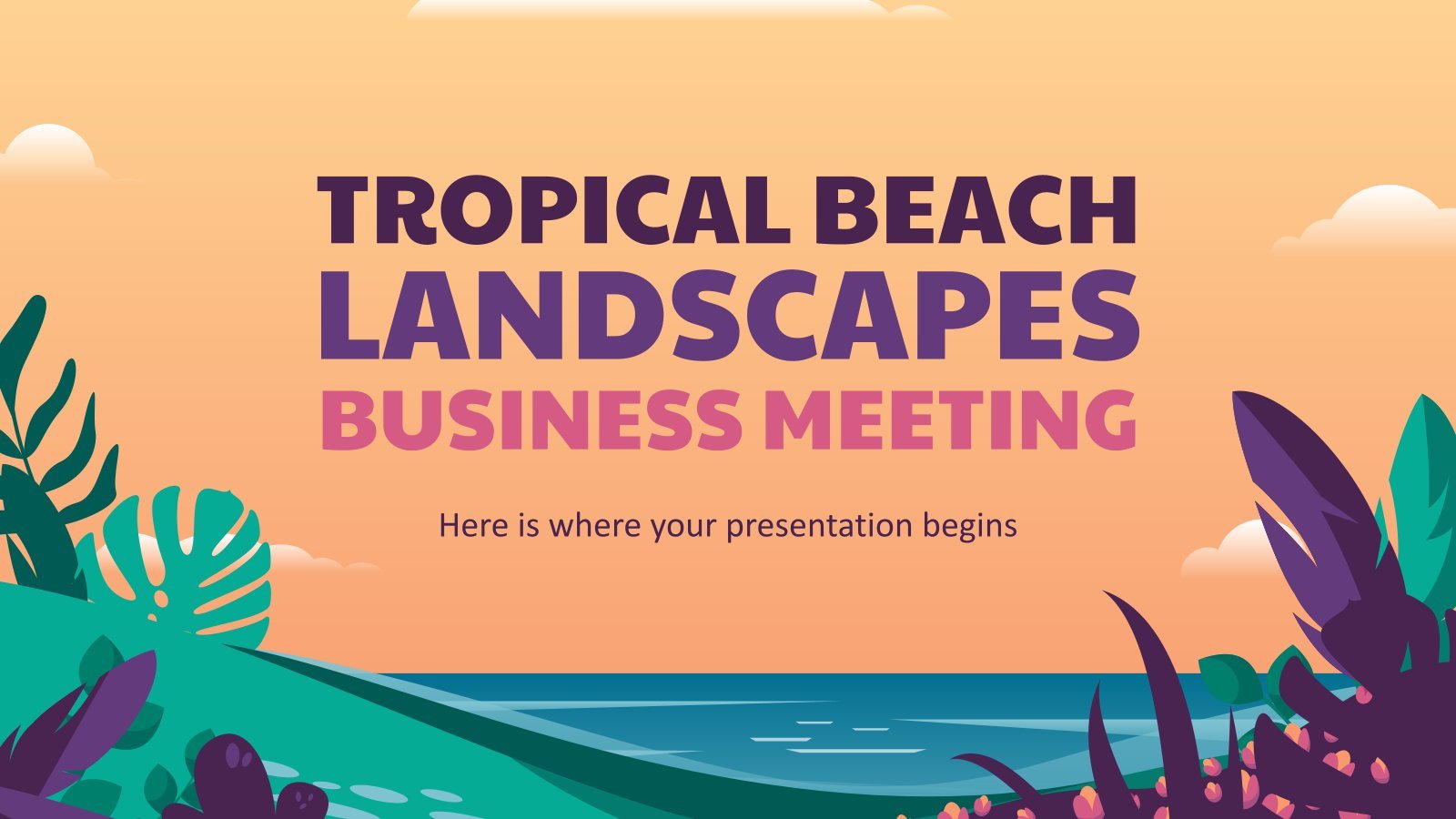
20 templates

11 templates
Spanish Presentation templates
This language is spoken by over 559 million people around the world and it is the second most studied language in the world spanish is so impregnated with culture that it has its own untranslatable words: vergüenza ajena, sobremesa, merienda, tapear, puente… lots of them have to do with food, what a surprise this selection of slides is in the language of pablo neruda, gabriel garcía márquez and isabel allende, do you feel like giving them a try.
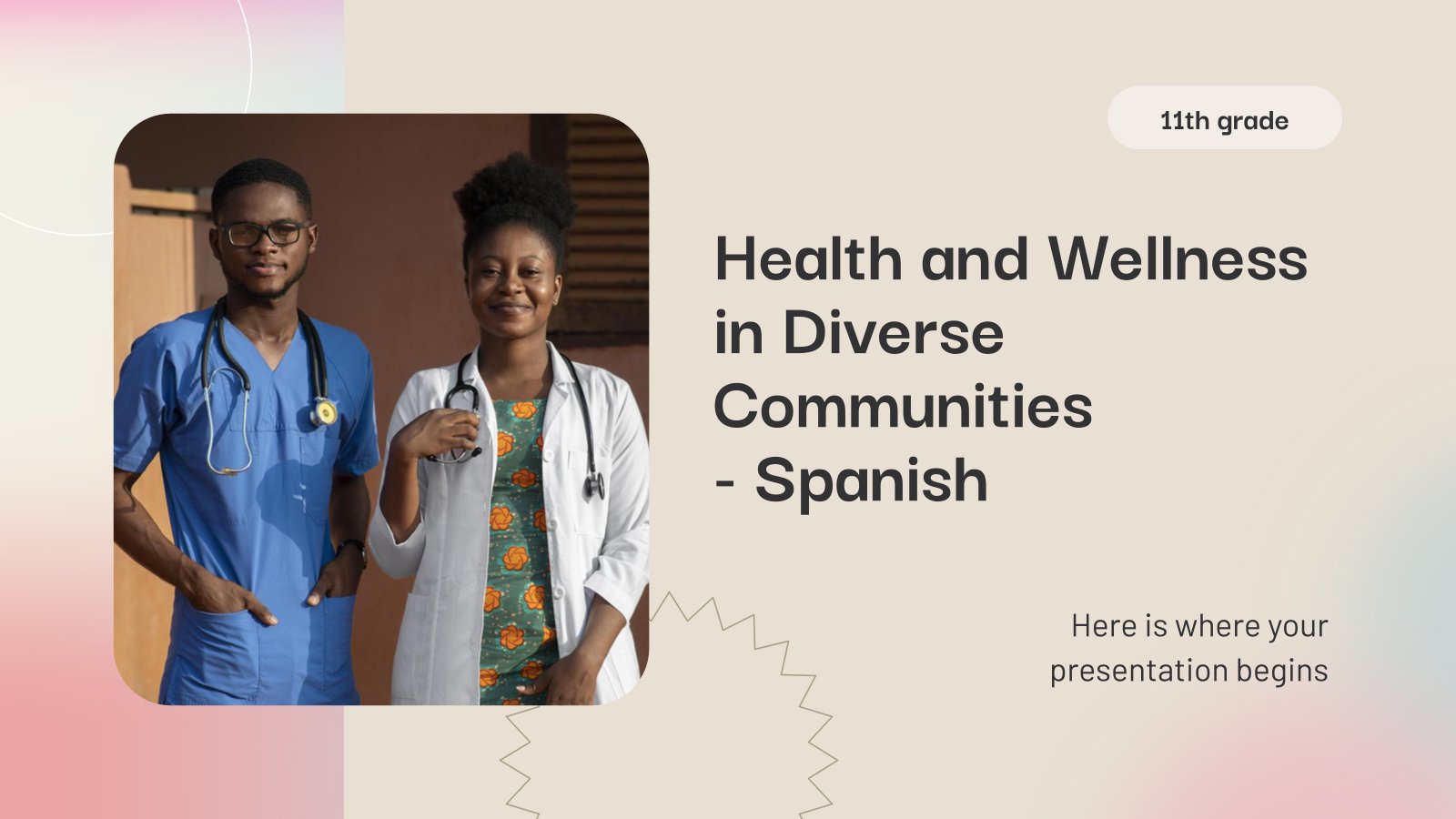
Health and Wellness in Diverse Communities - Spanish - 11th Grade
Download the "Health and Wellness in Diverse Communities - Spanish - 11th Grade" presentation for PowerPoint or Google Slides. High school students are approaching adulthood, and therefore, this template’s design reflects the mature nature of their education. Customize the well-defined sections, integrate multimedia and interactive elements and allow space for...

Spanish Culture and Civilization - Bachelor of Arts in Spanish
What do you think of Spaniards? Are they just a bunch of people who love to have siesta and avoid work? Prove those misconceptions wrong! Prepare a presentation about the Spanish culture and civilization, whether from a historic or a current point of view! What makes this country a special...
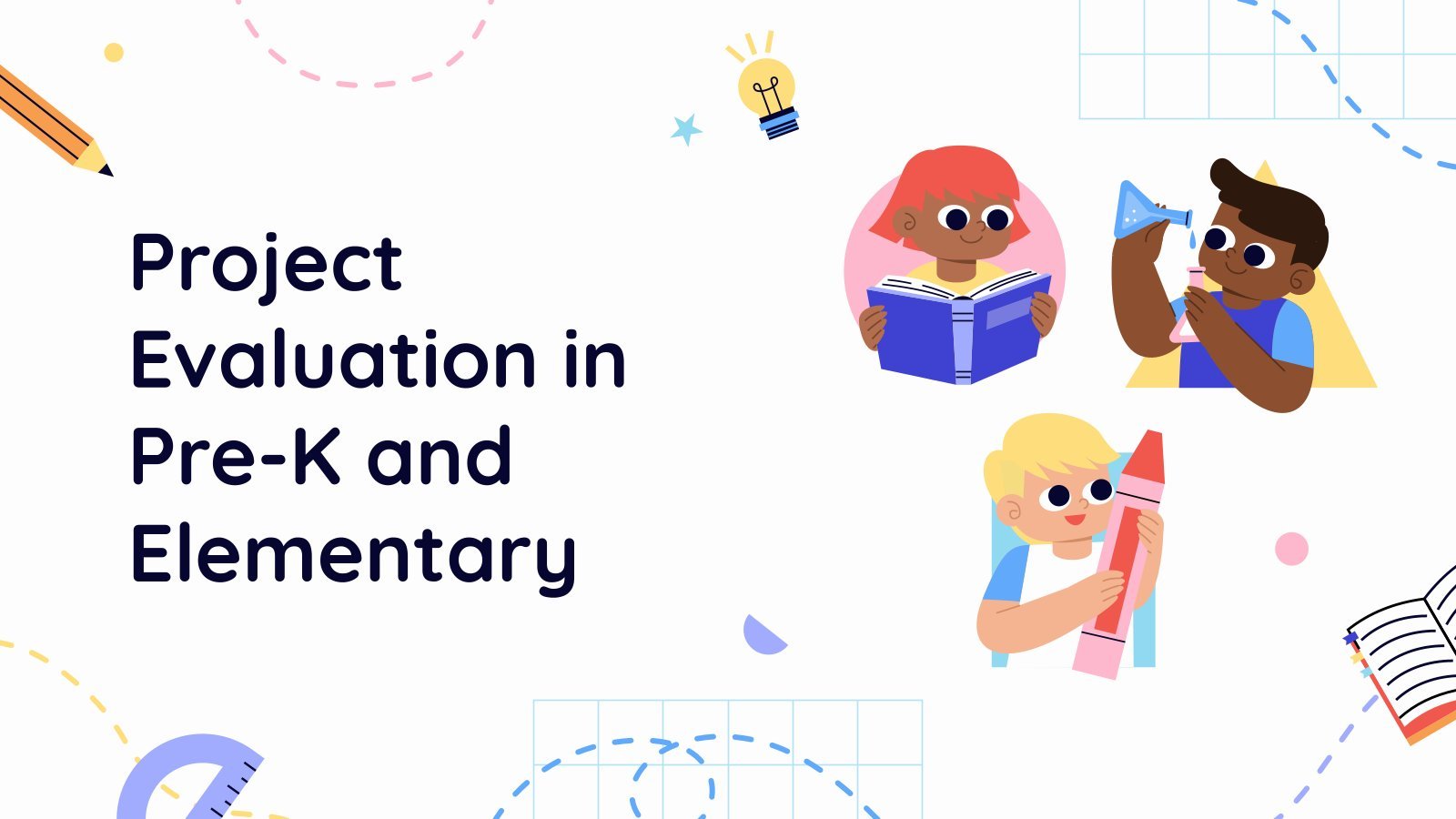
Premium template
Unlock this template and gain unlimited access
Project Evaluation in Pre-K and Elementary
Download the "Project Evaluation in Pre-K and Elementary" presentation for PowerPoint or Google Slides and prepare to receive useful information. Even though teachers are responsible for disseminating knowledge to their students, they also embarked on a learning journey since the day they decided to dedicate themselves to education. You might...

Spanish Vocabulary Workshop
Help students of Spanish language have a good grasp of the most common vocabulary used everyday by giving a workshop. List all the information on these slides, featuring a casual style, pictures and some sticker illustrations. Or you can use the template for your lesson and add the contents. Thanks...


Foreign & International Trade: Imports & Exports Infographics
Download the "Foreign & International Trade: Imports & Exports Infographics" template for PowerPoint or Google Slides and discover the power of infographics. An infographic resource gives you the ability to showcase your content in a more visual way, which will make it easier for your audience to understand your topic....

How to Encourage Reading in High School: 3 Activities
Download the "How to Encourage Reading in High School: 3 Activities" presentation for PowerPoint or Google Slides. High school students are approaching adulthood, and therefore, this template’s design reflects the mature nature of their education. Customize the well-defined sections, integrate multimedia and interactive elements and allow space for research or...

Food and Drinks Vocabulary - Spanish - Pre-K
Download the "Food and Drinks Vocabulary - Spanish - Pre-K" presentation for PowerPoint or Google Slides and create big learning experiences for the littlest students! Dynamic and adorable, this template provides the visual stimuli that Pre-K students thrive on and makes your lessons more playful and exciting — after all,...

Foreign Language Subject for Elementary - 2nd Grade: Spanish
¡Buenos días! Are you a foreign language teacher that wants to surprise your students with a creative, colourful and fresh template that makes them feel the Spanish feeling? This is the perfect template for you. It’s full of illustrations of typical Spanish things: beaches, flamenco dancers, bulls, food… and it...
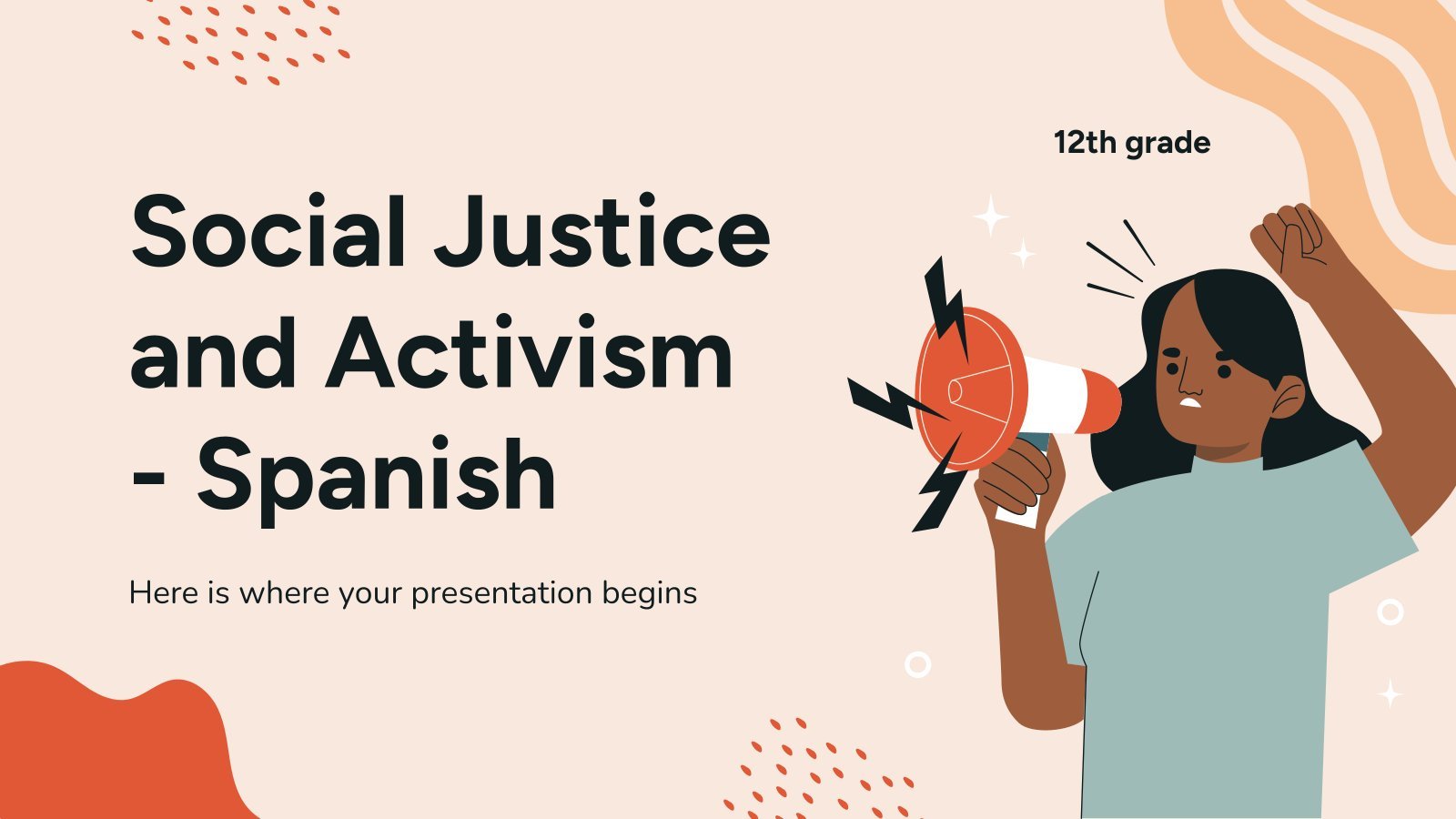
Social Justice and Activism - Spanish - 12th Grade
Download the "Social Justice and Activism - Spanish - 12th Grade" presentation for PowerPoint or Google Slides. High school students are approaching adulthood, and therefore, this template’s design reflects the mature nature of their education. Customize the well-defined sections, integrate multimedia and interactive elements and allow space for research or...
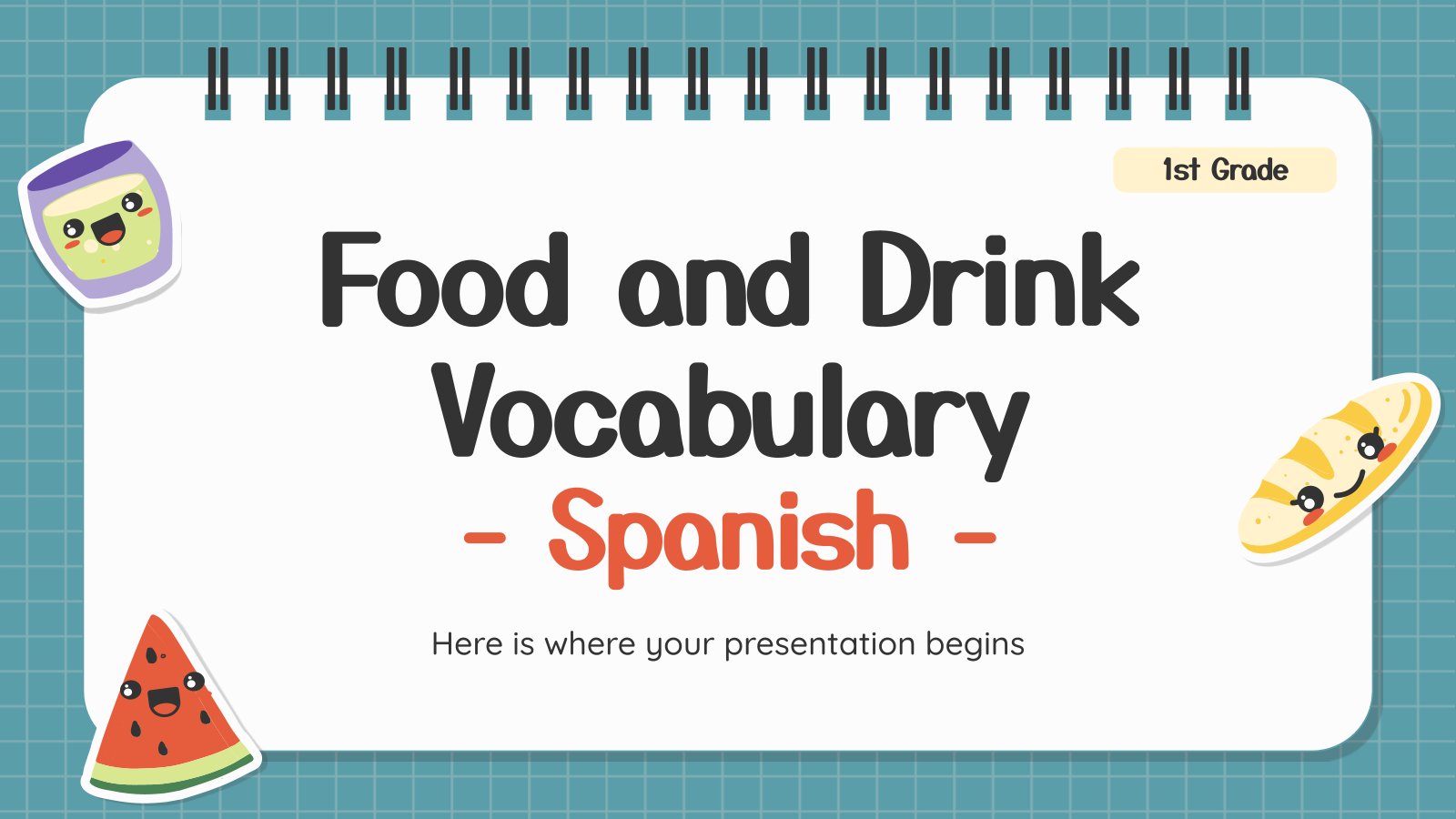
Food and Drink Vocabulary - Spanish - 1st Grade
Download the "Food and Drink Vocabulary - Spanish - 1st Grade" presentation for PowerPoint or Google Slides and easily edit it to fit your own lesson plan! Designed specifically for elementary school education, this eye-catching design features engaging graphics and age-appropriate fonts; elements that capture the students' attention and make...

Spanish Constitution Day
In Spain, every December 6 is Constitution Day, a national holiday in which people commemorate the anniversary of 1978's Spanish Constitution and the definitive transition to a democracy. To provide some history about this country, we have designed this new template. You'll be surprised at how easy it is to...

Minimalist Lines Marketing Plan
Download the "Minimalist Lines Marketing Plan" presentation for PowerPoint or Google Slides. This incredible template is designed to help you create your own marketing plan that is sure to impress your entire team. Using this amazing tool, you'll be able to analyze your target audience, assess your competitors, map out...
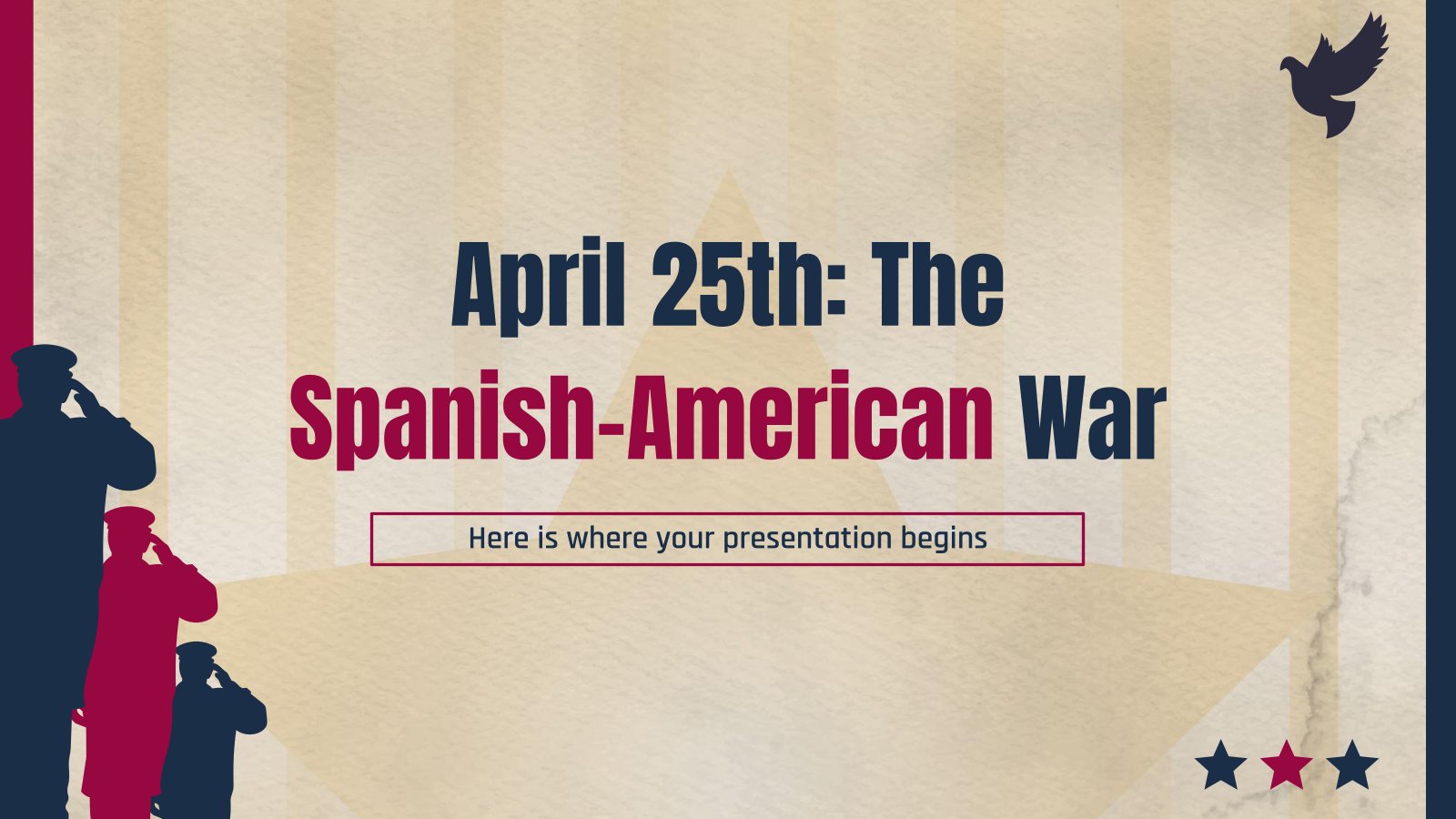
April 25th: The Spanish-American War
Download the "April 25th: The Spanish-American War" presentation for PowerPoint or Google Slides. The education sector constantly demands dynamic and effective ways to present information. This template is created with that very purpose in mind. Offering the best resources, it allows educators or students to efficiently manage their presentations and...

Mexican 5th of May
Mexico has one of the richest and most colorful cultures in all of Latin America, and this spectacular template faithfully represents it. Explore this presentation that we have designed with beautiful illustrations and colors for you to plan the celebrations of 5th of May, and commemorate this day as you...

My Needs, Wants, and Priorities
Download the "My Needs, Wants, and Priorities" presentation for PowerPoint or Google Slides and teach with confidence. Sometimes, teachers need a little bit of help, and there's nothing wrong with that. We're glad to lend you a hand! Since Slidesgo is committed to making education better for everyone, we've joined...

Diversity and Gender
Download the "Diversity and Gender" presentation for PowerPoint or Google Slides and prepare to receive useful information. Even though teachers are responsible for disseminating knowledge to their students, they also embarked on a learning journey since the day they decided to dedicate themselves to education. You might find this Google...

Time Boxing Step by Step
Download the "Time Boxing Step by Step" presentation for PowerPoint or Google Slides and teach with confidence. Sometimes, teachers need a little bit of help, and there's nothing wrong with that. We're glad to lend you a hand! Since Slidesgo is committed to making education better for everyone, we've joined...

History Subject for High School: First Mexican Empire
From 1821 to 1823, the First Mexican Empire was a short-lived regime that established Mexico as an independent nation. The establishment of the empire was a crucial step in Mexico's struggle for independence from Spain, and it remains an important era in Mexican history. If you're an educator, our template...
- Page 1 of 35
New! Make quick presentations with AI
Slidesgo AI presentation maker puts the power of design and creativity in your hands, so you can effortlessly craft stunning slideshows in minutes.

Register for free and start editing online
La presentación oral: 13 Ways to Teach it for AP Spanish Success
When my students first began giving oral presentations in my AP Spanish Language and Culture course, they had trouble for three reasons:
1. They had little knowledge of cultural practices in Spanish-speaking countries.
2. They struggled to finish within the two-minute limit.
3. Their presentations were completely disorganized.
In this blog post, I will explain how I addressed each issue so that my students were able to master the oral presentation section of the AP Spanish exam. Keep reading and get my F-R-E-E culture project on Spanish-speaking countries and famous hispanohablantes. Below are my best tips on how to teach la presentación oral.
1. STUDENT RESEARCH
Neither the teacher nor the students can predict what cultural practice will be mentioned in the presentational speaking section of the AP exam. Hence, the anxiety. However, just as those who live in Seattle must always have a raincoat within reach, students of AP Spanish must come equipped with knowledge of many traditions practiced in Spain and Latin America. Hence, the culture presentation. The more customs they are familiar with, the more likely it is that they will be able to answer the question with confidence. In order to fill their cultural knowledge bank, I assign a project.
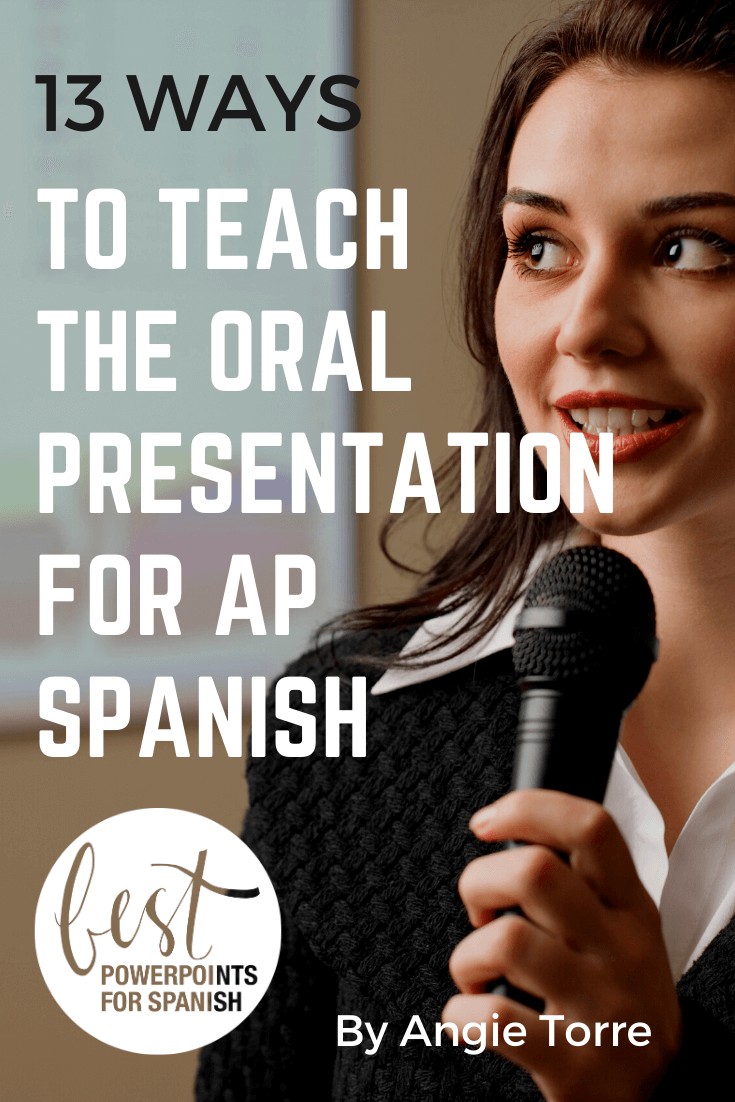
At the beginning of the course, I hand out instructions for a culture project. Students must do a Google search to find cultural practices or traditions of a Spanish-speaking country. They can either choose from articles in the textbook or find their own. If they select a tradition not in the text, I must approve their choices.
I hand out and explain the instructions, so students know the requirements.
THE PRESENTATION MUST:
- Have a visual component.
- Be five minutes long.
- Include comprehension questions for the class.
- Include a quiz for the class.
- Include an additional two-minute oral presentation comparing the cultural practice with one in their own country.
While the student talks, the observers take notes. Whenever students give presentations, I also include a graded, listening component for the observers so no one is sitting idly; students are always practicing their Spanish language skills, either speaking or listening. In this case, the students must evaluate la presentación oral according to the rubric, and answer comprehension questions in the student-created quiz.
After the presentations, the observers ask the presenter questions about his or her speech, then take the quiz.
Want more details? Click the following link to access the culture project I use: LA PRESENTACIÓN ORAL CULTURE PROJECT . These instructions are for Triángulo aprobado, but you can use them with Vista Higher Learning or any other textbook or test-practice booklet. Just replace the titles where appropriate.
2. TELL STUDENTS THE LEARNING GOAL
When I was a new teacher, I would anxiously sit down to grade a project and then feel my disappointed heart sink to my toes as I read each submission. How did the students miss the target by so great a distance? Because I had assumed they knew what I expected. Surely they knew they needed to include what to me were obvious elements. But they didn’t.
Students need to know exactly what is required of them. With that goal in mind, I tell them, at the beginning, what the learning objectives are. Then I give them the rubric with even more details. Below is the learning goal I give my students for the presentación oral comparing the grading system in the U.S. to that of a Spanish-speaking country:
Given a rubric of the oral presentation, vocabulary of comparisons, a PowerPoint on the Oral Presentation, and information on grading systems, students will do a two-minute oral presentation comparing the grading system of one Spanish-speaking country to the grading system in the United States.
HERE IS ANOTHER LEARNING GOAL:
Given information on Cartagena and Macchu Picchu, students will do an oral presentation comparing an American tourist attraction to Machu Picchu or Cartagena.
These topics were in the cultural texts of our AP Spanish test-prep booklet.
3. STUDENTS PRACTICE VOCABULARY FOR COMPARISONS AND FOR THE WRITTEN TEXT
Before students attempt to discuss the differences and similarities of various cultures, they need to have the vocabulary to do so; they need to know how to make comparisons in Spanish, and they need to know the vocabulary specific to the given topic.
I hand out a list of words and phrases students need in order to make comparisons and also vocabulary of challenging words from the text we will be reading.
The words don’t automatically become part of the students’ working vocabulary just because I handed them the list of words. They need to practice the vocabulary, to see the words in context, and to let them percolate in their brains (recognition phase). Then they draw a representation of the words, write the definition, and use them in context themselves (productive).
Below is part of the list of comparisons I give my Spanish students.
Vocabulario para la comparación
- Por un lado On the one hand
- Por otro lado On the other hand
- En comparación con In comparison with
- Si se compara…con If one compares…with
- Es cada vez más It’s more and more
- Es cada vez menos It’s less and less
- Mientras que X… While X…
- Se parece a… It is similar to
- Se diferencia en It differs in that
- Mejor / peor queue Better / worse than
- Aunque… Although / even though
- A la inversa Conversely
- De manera different Differently
- Sin embargo However
For example, I might say the following: Escojan dos palabras del vocabulario en la página 112. Hagan los cuadros y escriban una oración para cada palabra.
Students draw a square with four boxes. Sometimes, instead of writing sentences in the last box, I tell them to write synonyms in Spanish. Below is the demonstration I show them before instructing them to practice with the vocabulary.

4. LA PRESENTACIÓN ORAL: LAS INSTRUCCIONES
LEARNING TARGET: Students will plan and produce spoken presentational communications.
After students practice the vocabulary, we read the instructions and the exam description together, in Spanish, so they understand the requirements:
- They will have four minutes to read the topic and prepare their presentation.
- They will have two minutes to record their presentation.
- They will need to use the formal register.
- They will be comparing cultural characteristics / practices, traditions of the community in which they live with those of a Spanish-speaking country or Spanish-speaking communities with which they are familiar.
- They can use any of the following examples: information they have read, heard, or seen, or personal experiences or observations.
5. STUDENTS MUST ORGANIZE THEIR ORAL PRESENTATION
It is essential that students learn to organize their presentations, or they will not succeed on the exam. Organizing helps them think better and it also helps them stay within the time constraints.
In order to organize their speech, they must:
- Begin with a thesis statement that answers the question.
- Include words of the question in their thesis statement.
- Include developing paragraphs and a conclusion.
- Use a graphic organizer to prepare: I show students how to use a Venn Diagram and also a T graphic. On one side, students put the differences, on the other side, the similarities.

6. RUBRIC FOR PRESENTATIONAL SPEAKING
I read the College Board rubric for AP Spanish Presentational Speaking with the students so they know how they will be evaluated.
7. SHOW THE POWERPOINT
Then, I show my PowerPoint, which repeats the instructions (once isn’t enough) and gives more details of what is required. Below are a few examples of what students learn when watching the PowerPoint.
STUDENTS MUST:
- Demonstrate knowledge of the culture of a Spanish-speaking country.
- Speak fluidly.
- Provide details of the culture.
- Make themselves understood, speak with varied vocabulary and idiomatic expressions.
- Speak with good pronunciation.
- Correct themselves as they are speaking when they make mistakes.
- Commit few grammatical errors
- Read the question thoroughly.
- Use pausing or transition words to give them time to think such as, “así que, pues, entonces, además…”
The PowerPoint also shows several example introductions and thesis statements for a given cultural comparison including reasons number one and two. It also shows model text for developing paragraphs and a conclusion.

8. STUDENTS EVALUATE USING THE RUBRIC OR A CHECKLIST
After showing the PowerPoint, I give students a checklist of the required elements. After they read the model presentation, I check for understanding by asking students what the requirements are for a good presentation.
Then, students evaluate the model presentation according to the rubric or checklist using the college board grading system: They give an exam score of 1-5. (My checklist was created using the AP Spanish rubric for presentational speaking.)
An easy way to give students an idea of what a grade of 5 looks like is to have them listen to past exams and guess the score. Students hear presentations of scores ranging from 1 to 5. They then evaluate the presentation using a checklist. Once they guess, I show them what the real score was.
9. SELF-CORRECTING
I train students how to correct themselves during the presentation to improve fluidity and help them sound more like a native speaker. For example, I teach the vocabulary they will need when they misspeak, such as, “Es decir, mejor dicho, o sea, digo”.
10. READ THE CULTURAL NOTE
I read the cultural note in the textbook, test-practice booklet, or text I have provided. For example, I say: Lee la “Cápsula cultural: En las terrazas de Cuzco se puede cultivar más que hortalizas” en la página 111 en Triángulo aprobado.
Then I read the question. For example: Comparaciones: Compara la atracción turística de Machu Picchu con un sitio de tu país o comunidad.
11. SOLICIT DIFFERENCES AND SIMILARITIES USING THE GRAPHIC ORGANIZERS
I solicit “semejanzas y diferencias”. I write in students’ answers on a transparency (Boy am I old), smart board or whiteboard. Students take notes in their graphic organizer.
12. STUDENTS PRACTICE WITH A PARTNER
Working with a partner greatly decreases student anxiety and makes the task more fun. Also, students have the advantage of a peer tutor.
The first time students work on the oral presentation, I give them a full ten minutes to prepare. The more proficient they become in organizing their comparisons, the less time I give them. The last few months before the AP Spanish exam, students listen to the audio prompts which only allow four minutes to prepare.
13. STUDENTS PRESENT WITH PARTNERS AND EVALUATE EACH OTHER
Students now give their oral presentations using Google Voice, Audacity, or online using the publisher’s site. I time them for two minutes using a stopwatch.
One student at a time gives the presentation while the partner evaluates using the checklist. Students turn in the checklist.
I ask for two volunteers to present before the class for extra points. The entire class grades them according to the checklist.
14. BE EFFICIENT WITH TIME
Did I say 13 ways? Here is #14.
Time is always beating me with a whip as I prepare my students to pass the test. Therefore, I must find ways to use my time efficiently. A great way to save time is to work on two sections of the AP exam simultaneously. I instruct half the class to work on the oral presentation and the other half to work on the simulated conversation for the current AP Spanish theme, for example: Contemporary Life, or Global Challenges. Half the students are doing practice tests for presentational speaking while the other half works on interpersonal speaking. For example:
- Half the class does Conversación simulada p. 117 on Audacity or the Learning Site.
- The other half of the class does oral presentation on Google Voice or the Learning Site.
- Then they switch.
- The Spanish teacher times the oral presentation for two minutes. Remember to tell the test takers to say their name and let a few seconds pass first and to say who they are when using Google Voice.
If you would rather not do all the work yourself, you can use the Oral Presentation PowerPoint and Activities for AP Spanish Language and Culture to help students master la presentación oral portion of the AP Spanish exam. This valuable resource includes everything I have mentioned in this post.
These resources can be used with Triángulo aprobado Spanish Language books or Vista Higher Learning booklets or any AP Spanish Test-prep books. Google Slides digital versions are available, too.
The 28-slide Presentación Oral PowerPoint for AP Spanish includes the following:
- Instructions on how to do a cultural oral presentation for AP Spanish
- Required elements of an oral presentation
- A sample cultural question taken from Triángulo aprobado
- Two sample graphic organizers for the “presentación oral”
- Instructions on how to write the “oración de tesis” and how to organize the “presentación oral”
- A sample cultural oral presentation with the components labeled
- Expressions for self-correction
- Expressions for pausing and transition
- 24 words and expressions useful for making comparisons
- Four possible introductions
- Three possible “oraciones de tesis”
- Two sample developing paragraphs
- A sample conclusion
- Instructions for writing the conclusion
The printables include the following:
- a checklist for self-correction or partner correction
- a lesson plan for the oral presentation following the EDI format: the learning objective, attention-getter, tension, explain/model/demonstrate, checking for understanding, guided practice, closure, independent practice/homework, and items needed to present the lesson
- a graphic organizer
- a handout of vocabulary for making comparisons
- the password to open the PowerPoint YOU WILL NEED MICROSOFT OFFICE 2002 in order to access the password-protected PowerPoint.
This PowerPoint and Activities is included in the following bundle: A P SPANISH POWERPOINTS
How do AP Spanish students record their simulated conversations and oral presentations ?
So many of you have asked me what my students use to record their presentations. I will tell you what I used and also what other teachers use, so you have many options. BELOW ARE WAYS STUDENTS CAN RECORD:
- Google Voice (What I used)
- Vocaroo Online Voice Recorder (It’s free and I’ve heard great things about it.)
- Flip (Used to be FlipGrid.)
- Schoology, Canvas, or any LMS (Learning Management System) your school is using.
- Audacity (I have used this as well.)
- Vista Higher Learning SuperSite
- Student Phones (Voice Memo or Recording App)
- Google MP3 in Google Classroom
READY-MADE LESSON PLANS THAT DO EVERYTHING FOR YOU
If you don’t want to write the lesson plans yourself, use the ready-made lesson plans below. They do everything for you! And you can have confidence in them since all my students passed the AP Spanish Language and Culture Exam except one during the five years I taught AP Spanish.
AP Spanish Lesson Plans and Curriculum for Tríangulo apro bado
AP Spanish Lesson Plans and Curriculum for Vista Higher Learning
Would you like more free resources for AP Spanish? And more tips on how to teach it? Click on the links below.
F-R-E-E Lesson on the Argumentative Essay for Presentational Writing (Previously called the Persuasive Essay)
Simple Tips on How to Teach the AP Spanish Email Reply for Interpersonal Writing
How to Teach the Argumentative Essay
Why I Teac h AP Spanish the Way I Do
What do I Teach After the AP Spanish Language and Culture Exam?
I hope this post has given you some ideas to help your students master la presentación oral section of the AP Spanish exam. If you found this post helpful, send the link to a friend!
If you’d like to get more tips and f-r-e-e resources in your email, subscribe to my newsletter. Just click this link and scroll to the bottom to subscribe: Best PowerPoints for Spanish and French by Angie Torre. You’ll also get a F-R-E-E 122-slide PowerPoint on Spanish verbs and infinitives.
CONNECT WITH ME ON SOCIAL MEDIA:

- You are saving this new teacher countless hours of work!!! The preview showed great resources and examples for AP students can't wait to begin using! Worth every single penny. Gracias for all your time and energy spent on creating awesome curriculum! Angela A
- Such a lifesaver! Love the lessons! Creative and excellent resources. Thanks so much. You made my year much easier.
- My kids loved it and said it helped clarify this very difficult concept. Muchas gracias! Mrs. F's Room

Leave a Comment Cancel reply
I taught world language for 31 years and have created countless resources for Spanish and French during that time. I am a top seller on Teachers Pay Teachers and for the past 11 years I have devoted my time and energy to helping teachers save time, avoid burn-out, and bring their students to proficiency in the target language through the use of my proven resources. During the five years that I taught AP Spanish, all but one of my students (primarily non-native speakers) passed the AP exam most with fours and fives.
Privacy Policy Shipping Policy Refund Policy
Spanish One
Spanish Two
Spanish Three
Spanish Four
French Three
French Four
Start typing and press Enter to search
Privacy Overview

Guide: How to Say Presentation Slide in Spanish
Welcome to our comprehensive guide on how to say “presentation slide” in Spanish. In this guide, we will provide you with various ways to express this term, both formally and informally. We’ll also include some regional variations, if necessary. Whether you’re learning Spanish for business, education, or personal reasons, having the right vocabulary for expressing your ideas is crucial. Let’s jump right in!
Formal Ways to Say Presentation Slide
If you’re engaging in a formal setting such as a business meeting or academic conference, it’s important to use appropriate language. Here are a few formal ways to say “presentation slide” in Spanish:
- Diapositiva – This is the most commonly used formal term for a presentation slide in Spanish. For example, “Por favor, muestre la siguiente diapositiva” means “Please display the next presentation slide.”
- Lámina – Another formal option is “lámina,” which is often used in formal educational settings. You could say, “Incorpore esta información importante en su lámina” meaning “Incorporate this important information onto your presentation slide.”
Informal Ways to Say Presentation Slide
If you’re giving a presentation in a less formal environment or among friends, you can opt for more informal terms. Here are a couple of options:
- Slide – Many Spanish speakers also use the English word “slide” when discussing presentation slides casually. For instance, “¡Este slide contiene datos muy interesantes!” would mean “This slide contains very interesting data!”
- Pantalla – In some informal contexts, “pantalla” (screen) can also be used to refer to a presentation slide. For example, “Déjame mostrarte algo en la pantalla” would translate to “Let me show you something on the presentation slide.”
Regional Variations
Spanish is spoken in numerous countries, and there can be slight variations in vocabulary across regions. While the terms mentioned above are widely understood, you might come across some regional variations in certain places. Let’s take a look at a few examples:
- Slice – In some Latin American countries, particularly Mexico and Argentina, the English word “slice” is frequently used to refer to a presentation slide. For instance, “Por favor, muéstreme la siguiente slice” would mean “Please show me the next slide.”
- Transparencia – In Spain, the term “transparencia” is commonly used to mean a presentation slide. So, you could say, “Añade este detalle a la siguiente transparencia” meaning “Add this detail to the next presentation slide.”
Tips and Examples
1. providing clarification.
Example: Disculpen, me refiero a la diapositiva número dos. (Sorry, I mean slide number two.)
When referring to a specific slide within your presentation, it’s essential to provide clarification. Use phrases like “número de diapositiva” (slide number) to avoid confusion.
2. Emphasizing Key Information
Example: Resalten el gráfico en la lámina para captar la atención de la audiencia. (Highlight the chart on the slide to capture the audience’s attention.)
Using phrases like “resaltar” (highlight) or “captar la atención” (capture attention) can help you emphasize key information on your presentation slide.
3. Asking for Confirmation
Example: ¿Pueden ver la diapositiva correctamente en sus pantallas? (Can you see the slide correctly on your screens?)
It’s always a good practice to confirm if the audience can view the presentation slide properly. This shows your consideration towards their experience.
Congratulations! You’ve reached the end of our comprehensive guide on how to say “presentation slide” in Spanish. Remember, using the appropriate vocabulary in formal and informal settings will help you effectively communicate your ideas.
Whether you opt for the formal “diapositiva” or the more casual “slide,” you’ll be well-equipped to present your work or ideas to Spanish-speaking audiences. If you encounter regional variations like “slice” or “transparencia,” be open to understanding their meaning in the specific context.
We hope this guide has been valuable in expanding your Spanish vocabulary. ¡Buena suerte! (Good luck!)
Related Posts

How to Say "Continued on Next Slide" in a PowerPoint Presentation
Delivering a smooth and seamless PowerPoint presentation involves more than just preparing visually appealing slides. It's essential to communicate effectively with your audience, especially when transitioning from one slide to another. To indicate that your content continues on the next slide, you can use various phrases and techniques, depending on the formality of your presentation. In this guide, we will explore both formal and informal ways to say "continued on next slide" in a PowerPoint presentation, offering useful tips and examples along the way.
Guide: How to Say "Next Slide" in a Presentation
When giving a presentation, it is crucial to smoothly transition between slides to maintain the flow and engagement of your audience. One way to ensure a seamless transition is by clearly indicating when it's time to move to the next slide. In this guide, we'll explore both formal and informal ways to express "Next Slide" during a presentation. While regional variations are not significant in this context, we'll focus on providing useful tips and examples to help you deliver an outstanding presentation.
Guide: How to Say Thank You in Presentation Slides
Welcome to our comprehensive guide on expressing gratitude in your presentation slides! Being able to convey thanks effectively is crucial in building connections, showing appreciation, and leaving a lasting impact on your audience. In this guide, we'll explore both formal and informal ways of saying thank you on your presentation slides. While regional variations are important in certain contexts, we'll primarily focus on universal tips and examples to ensure you can express your gratitude in a warm and impactful manner. So let's dive in!
How to Say Present a Presentation: Formal and Informal Ways
Presenting a presentation effectively requires not only clear communication skills but also an understanding of the appropriate language and tone to use. Whether you're presenting in a formal setting or engaging in a more casual situation, having the right vocabulary and expressions can make all the difference. In this guide, we'll explore both formal and informal ways to say "present a presentation," offering you useful tips and examples along the way.
Guide: How to Deliver a Good Presentation
Delivering a successful presentation is an essential skill in both personal and professional settings. Whether you are presenting to a small group of colleagues or addressing a large audience, the ability to communicate effectively can make a significant impact on your message's reception. In this guide, we will explore various tips and techniques to help you deliver a remarkable presentation, focusing on both formal and informal approaches.
How to Say a Great Presentation: Tips and Examples for Formal and Informal Situations
Giving a presentation can be a nerve-wracking experience, but with the right preparation and delivery, you can captivate your audience and make a lasting impression. Whether you're presenting in a professional setting or a more casual environment, knowing how to say a great presentation is essential. In this guide, we will explore tips and examples for both formal and informal situations, providing you with the tools you need to excel. So, let's dive in and enhance your presentation skills!
Tips on How to Say a Presentation: Formal and Informal Ways
Giving a presentation can often be a nerve-wracking experience, but with proper preparation and practice, you can confidently deliver your message to your audience. In this guide, we will explore various tips and examples on how to say a presentation effectively. We will cover both formal and informal ways, providing you with insights on how to adapt your speaking style to different settings.
How to Say a Presentation Was Good: Tips and Examples for Both Formal and Informal Settings
Effective communication is crucial in both personal and professional settings, and being able to express your thoughts and opinions on a presentation is an important aspect of that. Whether you want to provide feedback to a colleague, commend a student's effort, or simply express your admiration, knowing how to say a presentation was good can go a long way in building relationships and fostering a positive atmosphere.
Cancel reply
Save my name, email, and website in this browser for the next time I comment.
Arabic Cantonese Chinese Dutch English Farsi Filipino French German Greek Hawaiian Hebrew Hindi Irish Italian Japan Japanese Korean Latin Mandarin Mexican Navajo Norwegian Polish Portuguese Punjabi Romanian Russian Sanskrit Sign Language Spanish Swahili Swedish Tagalog Tamil Thai Turkish Ukrainian Urdu Vietnamese

- Privacy Policy
You are using an outdated browser. Please upgrade your browser or activate Google Chrome Frame to improve your experience.
12 Spanish Presentations to Introduce Vocabulary to Beginners in Your Classroom
Presentations are amazing teaching resources ! We can’t deny it.
No matter your students’ learning style and no matter how much we try to incorporate the use of all the senses in our lessons, having a visual aid that keeps the students’ attention can really improve your instruction.
And let’s be honest, no other class will benefit more from visual aids than a language class full of beginners —especially when introducing vocabulary.
So check out these 12 pre-made presentations that you use in your classes!
What to Remember When Using These Presentations
12 spanish presentations to use in your classroom , 1. el clima/tiempo (the weather), 2. los animales (animals), 3. la familia (the family), 4. los colores (the colors), 5. las partes del cuerpo (parts of the body), 6. la cabeza (the head), 7. descripciones físicas (physical descriptions), 8. qué hora es (telling the time — o’clock).
- 9. Qué hora es? (Telling the time — quarter past, quarter to, half past)
10. Qué hora es? (Telling the time — remaining times)
11. la rutina diaria (daily routine), 12. los cuartos de la casa (the rooms of the house), the power of slides for spanish classes.
Download: This blog post is available as a convenient and portable PDF that you can take anywhere. Click here to get a copy. (Download)
Why reinvent the wheel? Here are 12 presentations already put together that you’re free to adapt to your lessons. If you don’t like a particular slide, just delete it or change it!
Most of these presentations come from a site called ¡Oye! , except for El clima , which comes from a site called Tpduggan . Both sites were created by teachers as resources for other educators.
To access the PowerPoints, click on the Spanish headings. You’ll be directed to the website where you can search for the title of the presentation. You can then choose and download the appropriate file.
You have several useful presentations to choose from, so let me give you a couple of notes before we start:
- ¡Oye! is a site that has presentations and exercises for each learning skill, divided into topics and school years. Many of the exercises can be used with an interactive whiteboard, although they also have a printed version. In order to use this site and download the presentations between the hours of 9 a.m. and 4 p.m. during the week, you need to be registered and pay a monthly fee . The rest of the time, access to the site is free. Keep this in mind when you’re preparing your lesson.
- Tpduggan is exclusively a site that collects PowerPoint presentations of all kinds: vocabulary, grammar, geography, exercises, etc. However, use them with caution because they use English a lot and have lots and lots of text . On the other hand, you can find lots of inspiration and ideas for creating your own presentations.
- Most of these presentations use drawings instead of pictures . Even though this may seem more appealing to children, it doesn’t mean older students or adults will mind them. However, you can always edit the presentations and change the pictures to something you consider more suitable for your class. After all, no one knows your students’ interests and needs better than you.
Description: This presentation teaches the names of the seasons and weather expressions that go with them. It’s perfect for introducing the vocabulary for the first time or reviewing it. Since all the pictures are drawings, it may be more appealing to younger children. If you feel real pictures may be better for older students, you can always edit the presentation and change the pictures.
Suggestions: One thing I do recommend you change is the first slide, ¿Qué tiempo hace? (What’s the weather like?), because beginners may get confused and think this is how we ask about the seasons. I’d change it to Las estaciones del año (The seasons of the year) or ¿Qué estación del año es? (What is the season?).
Description: This one contains vocabulary for animals (with drawings) and is under the section and title of “Pets.” It goes beyond the word and the picture and introduces structures to ask questions.
For example:
¿Es un gato? (Is it a cat?)
¿Qué es? (What is it?)
¡ Es un perro! (No! It’s a dog!)
In addition to that, it has animal sounds in the drill at the end—a definite plus and more fun for your students.
Suggestions: You can always change the drawings to real pictures or add more animals and questions according to your lesson or students.
Description: The presentation introduces the family members through an example of a family tree. It introduces new vocabulary while at the same time introducing basic sentence structures for discussing relationships.
Alicia es la madre de María. (Alicia is María’s mother.)
Luis es el hijo de Alicia. (Luis is Alicia’s son.)
Suggestions: My only suggestion here would be to ask your students to copy the family tree in their notebooks before you get to the true/false drill that tests their knowledge. Otherwise, they’ll be too focused on remembering who was who to remember the relationship between them. Let’s make it simple for them!
Description: This presentation introduces the colors. In the first slides, your students will learn how to ask ¿Qué color es? (What color is it?) and learn the correct term for each color. You’ll just need to edit a small mistake here: the word marrón (brown) is missing the accent.
In the last slides, your students will have to tell you which color results from the combination of two given colors.
negro + blanco = gris (black + white = gray)
Suggestions: This last part makes the color introduction a little more interesting since they’ll also have to think about color theory. They’ll love the fact that they’ll get drums as an anticipation sound before giving the answer and applause after giving the correct one. Make sure your computer has the sound on and the volume up.
Description: This one introduces and reviews the main parts of the body through a drawing of a girl. In the first slide, the body will slowly form part by part with each click, and you’ll see the name of the body part along with its proper article. The slides that follow are drills to review what students have learned.
Suggestions: In the first drill, students name the parts of the body that the arrows are pointing to and the answers are revealed with each click. The words are written on the slide to help students remember the correct spelling.
The final drill looks like a puzzle with random parts appearing. If you want to test their memory and spice it up a little bit, you can speed up how fast they appear.
The words won’t appear in this drill, just each part of the body. Because of that, another thing you can do to see if they remember the spelling of each word is to ask them to write down the name of each part as it appears (with their notes closed, of course).
Before this last drill, you have one slide that says: “Name the parts of the body as they appear on the screen.” My suggestion is to erase this English sentence. There’s no need for translated words in a language class, it’ll just distract them from the Spanish words.
Description: With a similar structure to the previous presentation, the head is formed part by part with each click and the name appears with its article. Afterward, there are a couple of practice drills to review them.
The drills also follow the same structure as with the presentation of the body. In the first drill, the parts of the face are indicated with arrows and the answer appears. In the second drill, the parts randomly appear without names.
Suggestions: Review them in the same way I suggested for the body.
Description: This presentation focuses on the description of the eyes and the hair. Your students will be able to answer the following questions:
¿De qué color son tus ojos? (What color are your eyes?)
¿Cómo es tu pelo? (What does your hair look like?)
They’ll also be given the proper vocabulary to answer:
Corto, largo, rizado, liso, rubio, pelirrojo (short, long, curly, straight, blond, red)
The first few slides are descriptions of different characters (in drawings) and the last ones are drills that ask your students to describe or answer specific questions about what other characters look like.
The task on the last slide is to draw a character according to the description. Because this last exercise can be really fun for them, you may want to consider adding a few more descriptions. Your students can then draw and compare their pictures.
Suggestions: One thing to consider: before you use this presentation in class, make sure you already taught them noun and adjective agreement.
And one small piece of advice. In this presentation, they’re referring to straight hair as liso but you could use the opportunity to teach your students about the language variations according to the place in which it is used. Many countries use lacio instead of liso when referring to straight hair. Here is a very interesting discussion on the topic. Hope it helps!
Description: The structures of all these presentations that have to do with time are quite similar: first there are examples on how to tell time, then there’s a drill where examples are mixed up for your students to practice. At the end, there’s the opportunity to add hands to the clock.
This first presentation shows students how to tell time to the hour, plus noon and midnight. You may need to add en punto (o’clock; sharp) to each slide or just write it on the board to emphasize that it’s another way to say it.
9. Qué hora es? (Telling the time — quarter past, quarter to, half past)
Description: This one shows students how to say y cuarto (quarter past), menos cuarto (quarter to) and y media (half past).
The hands of the clock aren’t always very clear, so you can either try to edit them or clarify to your students where the hands are supposed to be exactly.
Description: Students will learn how to tell times that are not on the hour, quarter-hour or half-hour.
I spotted an error that you’ll have to correct: on the eighth slide, instead of being la una y veinticinco (1:25) it actually shows la una y veinte (1:20), so make sure to edit it.
Description: This one shows a basic daily routine, as its name states. You should present it after teaching your students how to tell time since the last part of this presentation combines the activities of the routine with the time at which they happen.
At the end, you have the same activities and a clock next to each one that tells the exact time those activities happen. This allows them to practice the new daily routine vocabulary, telling time and the conjugation of the verbs.
Suggestions: The first part is the introduction of some basic activities such as despertarse (waking up), levantarse (getting up), vestirse (getting dressed), etc. They’re all in first person, but if you’ve already taught students the verbs in the present tense, ask students to conjugate the verbs in the third person.
So, one example shows a boy having breakfast with the slide saying Desayuno (I’m having breakfast). You’ll ask your students, “ ¿Qué hace él? ” (What is he doing?) They’ll then conjugate the verb correctly by telling you, “ Desayuna. ” (He’s having breakfast.)
Also, when combining the pictures with the times on the 13th slide, the second example may be confusing since the clock looks like it says siete menos veinte (6:40) instead of ocho menos veinte (7:40), so you may want to edit this one.
Description: The first part introduces each room. This will be drilled on the 12th and 13th slides. But on the 11th slide, you have pictures of objects (without their label) that you’ll find in these rooms like a bed, chair, lamp, etc. The question on this slide is ¿En qué habitación se encuentra…? (In which room is …?)
Suggestions: The goal is to practice the name of the room where these objects are, but since they have no label and your students probably won’t know their names, I suggest you print out the pictures of those objects with their names and distribute them randomly to your students before the lesson (or before the presentation).
Once you reach this slide, you can ask the student that has each object to either say the name, show the card or write it on the board to teach their classmates. This way you’re adding an interactive element in the middle of your presentation.
I’d also suggest you change the title to Los cuartos de la casa or add the article to En casa (at home) so that it becomes En la casa .
Another suggestion would be to either eliminate the last slide of the presentation or at least erase the English translation. I’d just keep the slide’s title ¿Cómo es tu casa? (What is your house like?) to encourage them to describe their own house (how many rooms, which floor they are on, etc.), but in the presentation, it’s unnecessary to have so much text. Just list any necessary vocabulary on the board.
Even though it’s been on the market for almost 30 years, PowerPoint is still a favorite when it comes to presentations.
It allows you to show pictures, graphics, charts and diagrams, or embed videos , songs and sounds. The possibilities are endless!
How about taking your students on a virtual tour with a photo presentation? Or teaching comparatives and superlatives through a set of slides of something your students can compare? Create a comic book , maybe? Or show them a sequence of events and encourage them to predict what will happen next when you’re teaching the future tense?
Even though it takes some time to create them, they’ll work for you for a very long time. You can easily adapt them to your lesson or to your students’ needs. If you prefer to create your own presentations, you can find plenty of tips and tricks online to make them awesome.
But don’t worry if you just don’t have the time. The internet has a ton of websites where teachers share their presentations and are free for you to download and use in your classroom. And you can still modify them to add your personal touch.
Now, I’m going to be brutally honest with you. In the world of Spanish presentations, finding good presentations to introduce vocabulary to beginners is not easy.
Here are some of the main problems I’ve encountered with Spanish presentations:
- The use of English to explain Spanish . These presentations may be appropriate for teachers but not for the students. We want them to get used to Spanish, and bombarding them with information in English won’t allow them to immerse themselves in the language we’re trying to teach.
- Lots of text . In any kind of presentation, this decreases the attention of the students and, therefore, the effectiveness of the message; either they listen to you or they read the presentation. But in a language class where you’re presenting new vocabulary, having lots of extra words is even worse.
- Not an absolute necessity. It’s important that you set your learning goals before you decide to use them and not the other way around. It’s important to be purposeful with PowerPoints and make sure it’s not the only way you introduce new vocabulary—the novelty will wear off and your students will get bored.
An ideal PowerPoint presentation for teaching vocabulary must be clear, concise, without paragraphs and with lots and lots of pictures—even more so when you are introducing words to beginners. And most importantly, they should only be in Spanish.
You want your students to associate the new word with an image (and maybe a sound), and you want them to remember it in Spanish.
Speaking of images and sounds, you may find great use in some of the fantastic learning material found on FluentU . With FluentU’s diverse and growing library of authentic content, students learn and live Spanish in an immersive fashion.
FluentU works for you as the educator as well! FluentU’s integrated teaching tools make it simple to monitor your students’ progress as they complete exercises and review the newly learned material. You’re sure to find content that can work wonderfully as a basis for PowerPoint presentations.
I hope you enjoy these resources and ideas for many (school) years to come.
And if at some point you decide to spend some time creating your own presentations, please share them online so you can help other teachers the same way they’re helping you now!
Enter your e-mail address to get your free PDF!
We hate SPAM and promise to keep your email address safe

- Learn Spanish with Julio
- Help me help you!
- Grammar Videos
- Notilocas (Crazy News)
- Phrases for Any Situation
- Spanish for the Airport
- Spanish For the Taxi
- At the Hotel
- PowerPoints
- #1: Why so difficult
- #2 Native Speaker Intuitions
- #3 The High Price of Cheap Information
- # 4 The Grammar Book Deception
- #5 Laser-Focused Program
Learn Spanish
Free spanish lessons and one on one spanish lessons too, powerpoints, free powerpoint lessons..
This is a selection of PowerPoint Presentations freely available on the Internet that I decided to put together here, as I consider them useful both for learners as well as for teachers who are in a rush and need quality materials for their classes. Most of these are not mine, as you will be able to see in the original credits that accompany them. I personally do not use them in my classes as I prefer to create my own, and I really have a blast doing so, but I know many teachers would love to get their hands on this stuff. So if that describes you, I would love to welcome you to enjoy these free Spanish Powerpoints!
- Pronunciation
- Try to pronounce
- Collections
Learn how to pronounce Welcome to our presentation
Welcome to our presentation.
- Very difficult
Have you finished your recording?

Quiz on Welcome to our presentation
{{ quiz.name }}
{{ quiz.questions_count }} Questions
Show more fewer Quiz
Collections on Welcome to our presentation
-{{collection.uname}}
Show more fewer Collections
Popular collections
Dutch vocabulary, american cities., bayern munich squad / player list 2020-21, popular quizzes.

Trending on HowToPronounce
- quetzal [es]
- Indonesia [es]
- Isabel [es]
- Alfonso Waithsman [es]
- Carin leon [es]
- mujica [es]
- mente enferma [es]
- rafael nadal [es]
- monterrey [es]
- Chelsea [es]
- Eliana Guercio [es]
- Ciudad CESAREA [es]
- Jean Paul Pineda [es]
- Enzo Perez [es]
- Mariano Navone [es]
Add Welcome to our presentation details
Thanks for contributing
You are not logged in..
Please Log in or Register or post as a guest
Welcome to our presentation should be in sentence

Welcome to our presentation in spanish pronunciations with meanings, synonyms, antonyms, translations, sentences and more.
The proper pronunciation of the word venice is, word of the day, latest word submissions, recently viewed words, flag word/pronunciation, create a quiz.

Faculty Resources
Powerpoints.

A full set of PowerPoint decks is provided for download below. All decks are tightly aligned to the modules in this course. Since they are openly licensed, you are welcome to retain, reuse, revise, remix, and redistribute as desired.
These PowerPoint files are accessible. If you do revise them, make sure to follow these guidelines for creating accessible PowerPoints .
Use this link to download all PowerPoint decks in a single .zip file (53 MB), or download each individual deck below:
Contribute!
Improve this page Learn More
- PowerPoints. Provided by : Lumen Learning. License : CC BY: Attribution
- Projector Screen. Authored by : Denis Shumaylov. Provided by : Noun Project. Located at : https://thenounproject.com/term/projector-screen/1211212/ . License : CC BY: Attribution

Privacy Policy
- Pronunciation
THE BEST SPANISH-ENGLISH DICTIONARY
Get more than a translation, written by experts, translate with confidence, spanish and english example sentences, examples for everything, regional translations, say it like a local.
Making educational experiences better for everyone.
Immersive learning for 25 languages
Marketplace for millions of educator-created resources
Fast, easy, reliable language certification
Fun educational games for kids
Comprehensive K-12 personalized learning
Trusted tutors for 300+ subjects
35,000+ worksheets, games, and lesson plans
Adaptive learning for English vocabulary

IMAGES
VIDEO
COMMENTS
Translate Welcome to our presentation. See Spanish-English translations with audio pronunciations, examples, and word-by-word explanations.
Aquí hay dos frases que puedes usar: "Mi presentación es sobre…". "Hoy me gustaría hablarte de…". Siempre es una buena idea darle a la audiencia un resumen o una descripción general de su presentación. Recuerda dirigirte a tu público tratándoles de USTED: "Permítanme darles una descripción general de la presentación de ...
One of the most common ways to say "welcome" in Spanish is by using the phrase "bienvenido" for a male or "bienvenida" for a female. These phrases can be used in a variety of situations, whether you are greeting someone at your home, a social event, or even a business setting.
1. Verify that you're using the word "welcome" as a noun in a sentence. An example of using "welcome" as a noun is, "The woman is offering a warm welcome to her long-lost brother.". 2. Say "bienvenida" when using "welcome" as a noun. "Bienvenida" is the literal translation of "welcome" in Spanish. "Bienvenida ...
Relax and Smile: A big part of the quality of the presentation is how comfortable you are with yourself. Even if you don't feel like you really know the content or you are worried about presenting in front of your class, your attitude will affect the perception the audience has of your knowledge. If you are able to get up in front of everyone ...
2. Tell an Anecdote. 55% of our communication stems from non-verbal language; everything our audience reads through our expressions, mannerisms, tone, etc., while 38% of our communication is vocal and 7% is words. Hence, the importance of telling a story at the beginning of your presentation, so your audience connects with what you are going to ...
Stage 1: Greetings and presentations in Spanish. 10 de diciembre de 2021 por Sergio. 00:00. 00:00. English translation of podcast audio. Spanish Route, episode ONE. Your guided route to Spanish. Good morning, good afternoon or good evening. Welcome to Spanish Route.
Many translated example sentences containing "welcome to the presentation" - Spanish-English dictionary and search engine for Spanish translations. ... we welcome the presentation by the Secretary-General of a comprehensive United Nations counter-terrorism strategy. ... You helped to increase the quality of our service. ...
Download TONS of FREE PDF lessons to learn Spanish twice as fast, click here https://bit.ly/3n73piOIn this video, we will teach you How to Give a Presentatio...
Permítanme dar más detalles sobre este punto. Let me elaborate on this point. Learn Mexican Spanish vocabulary you can use for preparing a presentation. In this FREE SpanishPod101.com lesson, you learn the words and get translations and audio lessons.
Download the "Health and Wellness in Diverse Communities - Spanish - 11th Grade" presentation for PowerPoint or Google Slides. High school students are approaching adulthood, and therefore, this template's design reflects the mature nature of their education. Customize the well-defined sections, integrate multimedia and interactive elements ...
These resources can be used with Triángulo aprobado Spanish Language books or Vista Higher Learning booklets or any AP Spanish Test-prep books. Google Slides digital versions are available, too. The 28-slide Presentación Oral PowerPoint for AP Spanish includes the following: Instructions on how to do a cultural oral presentation for AP Spanish
teach different themes and units. They are ready to download. We offer our own Powerpoints (labeled. as such), as well as a collection of Powerpoint from other. sources. There are Spanish presentations for every level. (lower/middle/high school). Teachers please feel free to use these Spanish teaching. resources, but we ask that you respect the ...
Welcome to our comprehensive guide on how to say "presentation slide" in Spanish. In this guide, we will provide you with various ways to express this term, both formally and informally. We'll also include some regional variations, if necessary. Whether you're learning Spanish for business, education, or personal reasons, having the right vocabulary for expressing your ideas is crucial.
For free. Translate documents, audio, and images on the go, anytime, anywhere! Translate Hello and welcome to my presentation. See Spanish-English translations with audio pronunciations, examples, and word-by-word explanations.
Spanish. English. dar la bienvenida. to welcome (greet gladly) recibir con gusto, recibir de buena manera, acoger con satisfacción, acoger con agrado, acoger con beneplácito. to welcome (receive positively) Let's take a look at some examples of the above verbs. examples.
12 Spanish Presentations to Introduce Vocabulary to Beginners in Your Classroom. Presentations are amazing teaching resources!We can't deny it. No matter your students' learning style and no matter how much we try to incorporate the use of all the senses in our lessons, having a visual aid that keeps the students' attention can really improve your instruction.
This is a selection of PowerPoint Presentations freely available on the Internet that I decided to put together here, as I consider them useful both for learners as well as for teachers who are in a rush and need quality materials for their classes. Most of these are not mine, as you will be able to see in the original credits that accompany them.
How to say Welcome to our presentation in Spanish? Pronunciation of Welcome to our presentation with 1 audio pronunciation and more for Welcome to our presentation. Dictionary Collections Quiz Community Contribute Certificate ...
A full set of PowerPoint decks is provided for download below. All decks are tightly aligned to the modules in this course. Since they are openly licensed, you are welcome to retain, reuse, revise, remix, and redistribute as desired. These PowerPoint files are accessible. If you do revise them, make sure to follow these guidelines for creating ...
1. (greeting) a. bienvenido a. ¡Bienvenidas a Orlando, chicas! Welcome to Orlando, girls! If this is your first visit, welcome to Portland.Si es tu primera visita, ¡bienvenido a Portland! 2. (when inviting) a. no direct translation. You know you're welcome to come and stay any time you want.